Archives of Feeling 1 Sensation, Connection, Community Trauma, Knowledge, Empathy RMIT Design Hub Gallery 19 AUG — 8 OCT 2022 RMIT Gallery 21 SEP — 10 DEC 2022 Archives of Feeling:
RMIT University acknowledges the people of the Woi wurrung and Boon wurrung language groups of the eastern Kulin Nations on whose unceded lands we conduct the business of the University.
RMIT University respectfully acknowledges their Ancestors and Elders, past and present. RMIT also acknowledges the Traditional Custodians and their Ancestors of the lands and waters across Australia where we conduct our business.
2
Archives of Feeling 3
by Paula Toal, Head, Cultural and Public Engagement, RMIT Culture
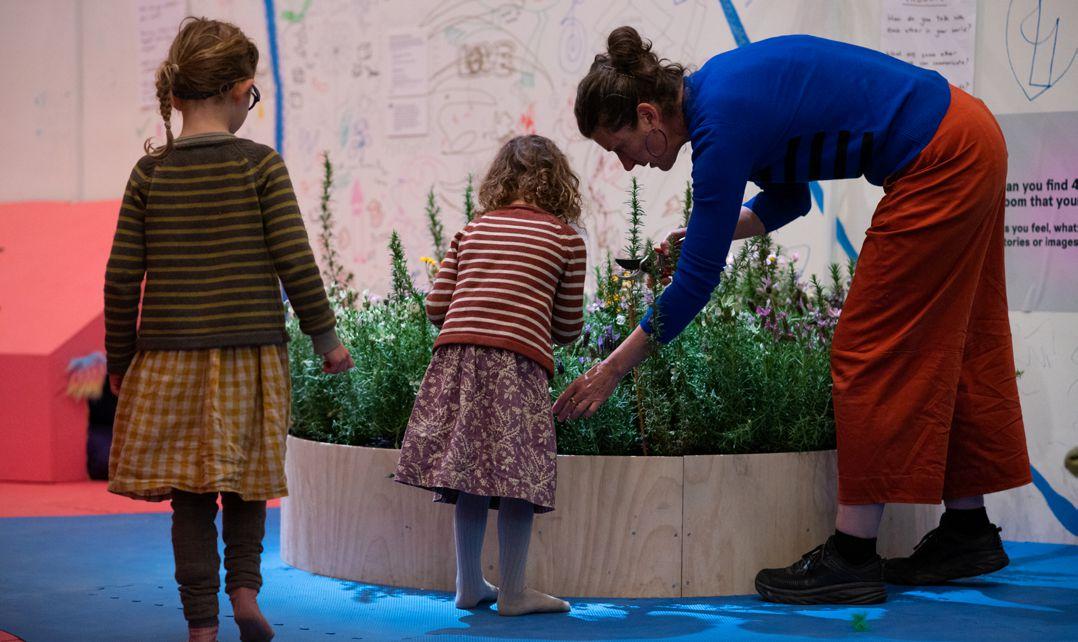
4
Foreword
Miniature Worlds, a workshop guided by Heather Hesterman for The Children’s Sensorium in Archives of Feeling: Sensation, Connection, Community. Image courtesy of the artist. Photograph by Keelan O’Hehir.
RMIT Culture is thrilled to present Archives of Feeling, an exhibition in two parts across RMIT Gallery and RMIT Design Hub Gallery as part of The Big Anxiety Melbourne Naarm 2022. The Big Anxiety is a collaborative partnership between RMIT University and UNSW presenting a creative response to the mental health challenges of our day. In the wake of the pandemic and in light of the Royal Commission into Victoria’s Mental Health System it could not be more clear that mental health is a community responsibility and creative practice is a powerful vehicle for recovery and renewal.
Archives of Feeling: Trauma, Knowledge, Empathy at RMIT Gallery and Archives of Feeling: Sensation, Connection, Community at Design Hub Gallery bring together a thoughtful selection of contemporary practitioners exploring the felt dimensions of trauma and wellbeing through a lens of lived experience. The participating artists and researchers interrogate mental health and our individual and collective understanding of it. The curators have led collaboration with community and artists creating a visceral and emotive relationship between the works. The result is a moving, immersive, and intimate viewing experience.
Set amongst many projects within Archives of Feeling: Sensation, Connection, Community we encounter The Children’s Sensorium developed by Dr Grace McQuilten and guided by Boonwurrung elder, N’arweet Carolyn Briggs drawing on the themes of nature using the Kulin calendar and supported by VicHealth. Foregrounding the importance of supporting and building resilience for our young people, having been so deeply impacted by the pandemic, this all-encompassing, participatory experience encourages children and their families to explore their senses, feelings, thoughts, and worries — smelling, touching and listening — to find comfort in this complicated world. It has been a delight to watch children and their carers fully interacting with the works on display.
Sincere thanks to the many contributing artists who were all deeply engaged, generous and responsive to contextualising their practice within the curatorial framework of Archives of Feeling. I would like to acknowledge Professor Ann Cvetkovich, Director of the Pauline Jewett Institute of Women’s and Gender Studies, Carleton University, Ottawa, whose research to move beyond clinical representations of trauma and make space for lived experience informed the curatorial frame for the exhibition.
I extend my warm thanks and congratulations to cocurators Dr Kelly Hussey-Smith and Dr Grace McQuilten for their vision, commitment and collaborative spirit which brought this project to life. To my RMIT Culture team I wish to acknowledge the dedication and hard work that helped realise this ambitious project, in particular the Galleries team led by Helen Rayment and Andy Tetzlaff and the Production team led by Erik North and Tim McLeod. Further thanks must be expressed to The Big Anxiety Co-Directors Professor Renata Kokanović, RMIT University and Scientia Professor Jill Bennett, University of NSW for their passion and drive to realise The Big Anxiety in Melbourne and as ever to Adam Seedsman, Executive Director, RMIT Business Development and Partnerships for his continued enthusiasm and enabling support of RMIT Culture.
Archives of Feeling 5
Archives of Feeling
 by Kelly Hussey-Smith, Grace McQuilten, Helen Rayment and Andrew Tetzlaff
by Kelly Hussey-Smith, Grace McQuilten, Helen Rayment and Andrew Tetzlaff
6
10
page 18 Beyond
page 40 Contents
page
Archives of Feeling: Sensation, Connection, Community exhibition images
the Fringe by Brian McKinnon

Archives of Feeling 7
of Feeling: Trauma, Knowledge, Empathy exhibition images page 44 From the Still Ongoing Archive of Pandemic Feelings by
page 66 Biographies page 72 Colophon page 78
Archives
Ann Cvetkovich
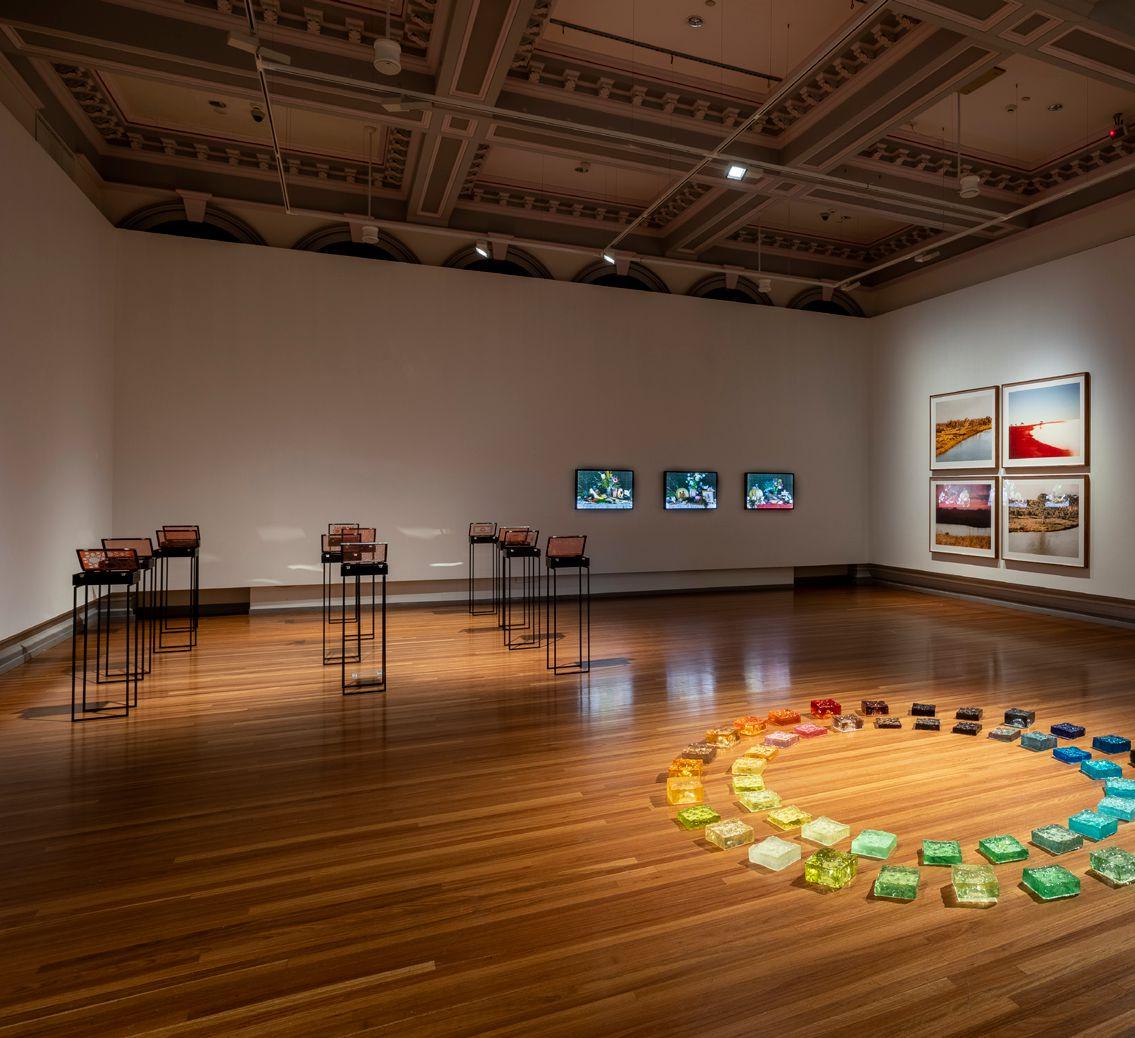
8
Installation image of Archives of Feeling: Trauma, Knowledge, Empathy. Image includes works by Rushdi Anwar, Maree Clarke, Peta Clancy, Yi Won Park and Jude Worters. Image courtesy of the artists, their representatives and the collections from which these works were loaned.

Archives of Feeling 9
Archives of Feeling
by Kelly Hussey-Smith, Grace McQuilten, Helen Rayment and Andrew Tetzlaff
A black knitted jumper, suspended from the ceiling with long, dangly arms that menace the floor and collect together in nondescript shopping bags. A grid of six, separately vacuum-packed stacks of colourful clothing. Seventy-six artworks by nurses, midwives and community members responding to the tremendous pressure on healthcare workers and their families during the COVID-19 pandemic. The transgressive drawings of hundreds of children covering the gallery walls. One hundred and four drawings of boats, all created by the residents of the Taipei Veterans’ General Hospital Yuli Branch in Hualien.
Together in this exhibition these fragments represent a larger archive of feelings — fragments which form both singular expressions of human experience, and which also collect to form community archives. This evolving archive speaks to the ubiquity of trauma experiences in our daily lives; experiences which, although common, are sometimes hard to express and often not explicitly addressed in the business of art and exhibition-making.
Archives of Feeling explores and imagines new ways to communicate and record the affective, sensorial and ongoing dimensions of trauma, recovery and the spaces in between. This exhibition centres on the knowledge produced by individuals and communities with lived experience. It uses the notion of the archive as a framework and seeks to contribute new kinds of archives — of lived experiences and artworks — that enable social, political, relational and sensorial understandings of trauma.
Artists and communities have long used creative and cultural practices to express the felt dimensions of traumatic experience. As queer feminist theorist Ann Cvetkovich (2003) has argued, we need new kinds of archives to express the affective and ongoing dimensions of trauma that centre the knowledge of trauma communities. In her book, An Archive of Feelings: Trauma, Sexuality, and Lesbian Public Cultures, Cvetkovich suggests that trauma is an important site of theoretical and cultural understanding because of the way it acts as a ‘hinge
10
between systemic structures of exploitation and oppression and the felt experience of them.’1 Including our affective selves into trauma archives can help us move beyond clichéd or clinical representations of trauma and make space for the knowledge developed by communities, cultures and individuals with lived experience. 2
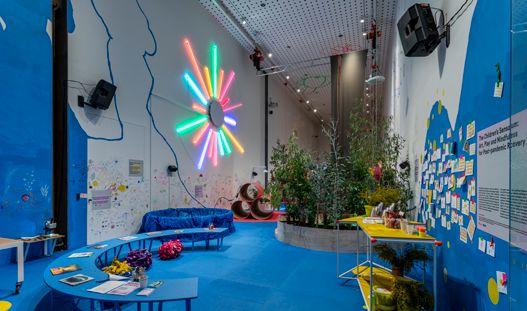
By combining traditional exhibition practices with creative media and participatory methods of collaboration and community building, this exhibition aims to transform the gallery into a living, growing and expanding ‘archive of feelings.’ It is an active archive through which to engage with stories; to unlearn pathologised and stigmatised understandings of trauma and relearn community understandings of mental health; engage with critical theories developed by survivor communities; and to engage with practical resources for living with trauma.
The exhibition moves beyond the idea that art about traumatic experience is simply a cathartic process. Instead, the artists in the exhibition propose that art about trauma is knowledge expressed on its own terms. By framing trauma as a continuum rather than an event, the artists in the exhibition show us how traumatic experience intersects with and manifests in everyday life. They show us how trauma can hide in plain sight — in lands and waters, collective memories, state archives and collections, medical systems, institutions and in the home.
As a series of exhibitions and projects, Archives of Feeling is a proposition which offers new ways of both archiving experience and experiencing archives. The exhibition is part of The Big Anxiety festival, a festival that brings together creative thinkers to re-imagine mental health care for the 21st century. While The Big Anxiety takes multiple approaches to this question — engaging both art-led science and science-led art — at its core is a focus on the knowledge of lived experience. Building on this framework, this exhibition works from the premise that individuals with lived experience of trauma and recovery, and in particular Elders and Seniors in trauma communities, are the experts on living with and through these varied experiences commonly labelled as trauma.
The exhibition is composed of two parts, each located in a different gallery and with intersecting opening dates. RMIT Design Hub Gallery houses the first part of the exhibition, Archives of Feeling : Sensation, Connection, Community (19 August to 8 October). This exhibition explores how participatory, collective and sensory approaches to artmaking and exhibition building can unpack the complex, lived dimensions of trauma and recovery while engaging new ways of producing and experiencing art exhibitions. With leading artistic direction from Boon Wurrung Senior Elder N’arweet Carolyn Briggs and produced as a pilot research project by Grace McQuilten, The Children’s Sensorium activates children’s senses and connects them to Country, providing a space in which children can explore and process big feelings, create, be in their bodies and lie down and dream.
1 Cvetkovich, A. (2003). An Archive of Feelings: Trauma, Sexuality, and Lesbian Public Cultures. Duke University Press, p. 12. 2 Ibid., pp. 11-12.
Archives of Feeling 11
Installation image of The Children’s Sensorium in Archives of Feeling: Sensation, Connection, Community. Image courtesy of the artists and their representatives.
Installation image of The Nurses and Midwives Art Exchange in Archives of Feeling: Sensation, Connection, Community. Image courtesy of the artists.

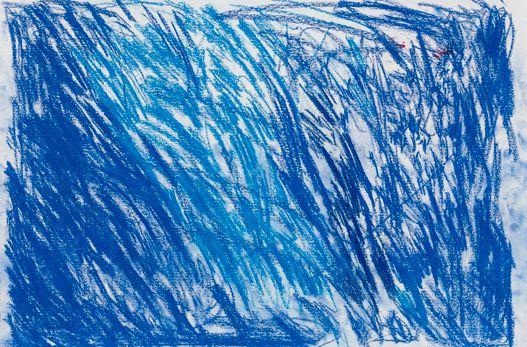
A colourful, interactive and experiential space, The Children’s Sensorium features co-created artworks by children (drawings on the walls and ceiling) and local sounds from Boon Wurrung Country developed by sound artist Philip Samartzis including bird calls, frogs (the exhibition coincides with Poorneet, tadpole season), water, wind and thunder, along with plants and trees (Heather Hesterman), smell-pods (Anna Schwann), light and colour (Fiona Hillary), colourful tactile forms and textures (Hiromi Tango) and opportunities for embodied and sensory play (Live Particle, Larissa Hjorth/Playbour and Tamara Borovica). The collective and collaborative art project responds to the impacts of the COVID-19 pandemic on children and families by offering pathways for mental health support, reflection and recovery.
In parallel, and in relationship to The Children’s Sensorium is an installation of sand, tree branches, light projections and sounds developed by the Ngaanyatjarra Pitjantjatjara Yankunytjatjara Women’s Council Aboriginal Corporation (NPY Women’s Council) to support individual and collective healing from trauma. This work developed out of the group’s Uti Kulintjaku mental health literacy project. The Pitjantjatjara phrase ‘Uti Kulintjaku’ means ‘to listen, think and understand clearly,’ and the project generates new
approaches to trauma-integrated mindfulness and wellbeing that are grounded in connections to language and Country. As visitors move out of The Children’s Sensorium and the NPY Women’s Council installation, they encounter a large installation of 76 works that together form The Nurses and Midwives Art Exchange. Despite many parts of the world returning to ‘business as usual,’ the COVID-19 pandemic and its impacts are far from over. The Nurses and Midwives Art Exchange acknowledges that frontline workers, and nurses and midwives in particular, have recently experienced increased workloads, stress, burnout, exposure to illness and abuse. While they have been acknowledged as heroes, their collective requests for protection, fair pay, recognition and safe and manageable workloads have not been met with the same enthusiasm. The project, which is produced by Kelly Hussey-Smith, features creative works from 38 nurses and midwives and 38 local artists who have responded to the nurses and midwives works. In the final days of the exhibition, the installation of this archive will change as the artists’ works are removed and gifted to the participating nurses and midwives.
12
A Hua, Ocean, 2017, drawing. A part of Che-Wei Chen, The Vessel of Time (I), 2017. Image courtesy of the artists.
Also drawing on community contributions, The Vessel of Time by Taiwanese artist Che-Wei Chen presents an archive of drawings from the residents of the Taipei Veterans’ General Hospital Yuli Branch in Hualien. Each drawing responds to the idea of a ‘vessel,’ mostly exploring naval themes and journeying by water, penned by hand with soft, colourful pencils. Collectively, the 104 drawings map lived experiences of travel and displacement with a lightness of touch that belies the complex context of psychiatric internment following the traumas of military service and war. This more complex archive of lived experience comes to life in the video work installed at the far end of the grid of drawings; a video that enables individual residents to tell their stories of war, of mental health issues and of psychiatric treatment. In contrast, the work of Thembi Soddell provides a more intimate encounter with the intangible and ambiguous qualities of trauma. Soddell uses abstract, acousmatic sound to give form to their own lived experiences of complex trauma, bringing visitors into a very different world of sensation. Here, visitors are invited to enter into a pitch-black environment alone and to open their ears in the darkness. The work is as much an internal and idiosyncratic experience as a sensory one, which Soddell invites visitors to reflect on through journaling.
The second exhibition, Archives of Feeling : Trauma, Knowledge, Empathy, is presented at RMIT Gallery (21 September to 10 December) and turns its focus from the sensory and community aspects of trauma to the questions of knowledge, memory and critical forms of empathy. Drawing from the felt Experience & Empathy Lab (fEEL) we engage a critical reading of the term ‘empathy’ that seeks to move beyond simplistic assumptions of ‘knowing another’s experience’ or ‘identifying with’ through exposure or proximity to a person or their story. As writers and artists from critical race studies and cultural studies highlight, this understanding of empathy does little more than reproduce
the logics of dominant culture — whereby the act of consuming difference can end up erasing it entirely.3 In this exhibition, ‘empathy’ is understood as a site of possibility where ‘entangled caring concern coupled with critical questioning’ can motivate connections to the structural forces and systems of oppression that cause harm.4 This kind of ‘entangled empathy’ — where our relational entanglements and responsibilities work to shape our complicity in these worlds — might express more aptly what the artists in this show are doing through their work.5
As many First Nations scholars, activists and communities have stated, First Nations people and communities are the experts on the structures and impacts of colonisation. In Archives of Feeling , First Nations artists Brian McKinnon, Maree Clarke, Peta Clancy and Julie Gough unpack the complex relationship between colonial violence, collective histories and their individual responses to trauma, colonial violence, ancestral history, and place. Amungu and Wongai man Brian McKinnon’s large-format paintings call out
3 See for example Bery, Sadhana (2022), “White Empathy: A Technology of White Supremacy” in The Racial Imaginary Institute (eds) On Whiteness, SPBH Editions: London

4 Gruen, Lori (2022), Empathy Beyond Whiteness in The Racial Imaginary Institute (eds) On Whiteness, SPBH Editions: London. p. 146.
5 Gruen, Lori (2022), Empathy Beyond Whiteness in The Racial Imaginary Institute (eds) On Whiteness, SPBH Editions: London.
Archives of Feeling 13
Peta Clancy, Fissures in Time 4, 2017, inkjet pigment prints. Image courtesy of the RMIT University Art Collection.
institutional racism, literally in black and white paint, and point to the ongoing and everyday experience of this intergenerational trauma. The paintings sit between two cultures and are a wake-up call to addressing the ongoing impacts of colonisation. Mutti Mutti/Wamba Wamba/Yorta
experience and perspectives of generations of Aboriginal women.6
Like Clarke, Tasmanian Aboriginal woman Julie Gough also approaches archives from the perspective of the personal and the familial. Gough’s work is a response to her experience of discovering a letter penned by the director of the Tasmanian Museum and Art Gallery (TMAG) in 1899, which expresses his intent desire to exhume and obtain the skeleton of a woman that Gough can only assume to be one of her Ancestors. The traumas of colonisation and intrusive museological practices are not washed away by the river waters of Gough’s work — instead, they resurface in them as a continuing reminder of the damage still being caused. Peta Clancy also presents images of Country and of ancestral memory, composing layered photographs that explore multiple time frames and perspectives. Her works reveal both the distance and the ‘presentness’ of history, here reflecting on the scars of European settler violence perpetrated on Aboriginal peoples in Victoria in the 19th Century that continue today.
Yorta/Boonwurrung woman Maree Clarke recreates elements of her grandmother’s loungeroom at Manatunga Reserve, reflecting on the 1967 referendum as a historical juncture of cultural politics and identity. In Made From Memory I, II, and III Clarke connects the 1967 referendum to the current campaign for Constitutional Recognition stating:
My maternal grandmother lived [at Manatunga Reserve] at the time of the referendum, a moment pregnant with expectation and hope for a reformed national identity. This work is critically positioned at the edge of another such juncture in Australian history, as the nation struggles with constitutional amendment, but takes a deeply personal, and matrilineal perspective that privileges the interior, lived
The trauma of forced displacement drives much of Rushdi Anwar’s installation practice. Drawing on his experience as a Kurdish refugee, Anwar’s work references a range of conflicts and divisions, from ISIS’ attacks in Iraq to Guantanamo Bay and the historic impacts of Islam and Christianity. Closer to home, experiences of religion, culture, displacement and childhood trauma bind the T-collective — a group of four mature-age artists and RMIT postgraduate researchers with shared experiences of personal and institutional trauma. Formed at RMIT, the T-collective aims to produce ‘a more rigorous dialogue around trauma’ that ‘departs from perceptions that trauma art is about catharsis and isolates the artists as victim.’7 In his ongoing work Trauma/Pre Trauma, Simon Crosbie explores displacement and power through his experience of abuse at an Australian
6 Clarke, Maree (2020-21) Artist Statement
7 T-collective (August 2022), from conversation and correspondence

14
Yi Won Park, Between Water and Light (detail), 2022, cast resin sculpture installation. A part of the T-collective. Image courtesy of the artist.
boarding school. Crosbie’s two oversized hand knitted jumpers, with five dangling sleeves speak to the ongoing dimensions of these experiences. Jude Worters also uses the language of garments and clothing to unpack and consider childhood memory, the legacy of trauma and the discomfort of not ‘fitting in.’ Mig Dann depicts the grief of losing her life partner through a series of six vacuum-packed bags of her clothes. As if documenting a last breath, the bags of colourful clothing form an archive that both holds and withholds the smells, textures and shapes of a loved one. Yi Won Park’s work also draws on the loss of a loved one. Park uses art to make sense of her parents passing and to acknowledge its connection to her personal experience of belonging, placemaking and cultural identity.
Argentinian artist Mariela Sancari also explores loss and grief through the notion of fiction, performance, and the unobtainable archive. Sancari’s father died by suicide in 1980, and because she never saw his body, she felt unable to accept his death. As a result, she continued to glimpse him everywhere. For the work Moisés, Sancari placed an ad in the local newspaper asking men in their 70s, around the age her father would have been, to allow her to take portraits of
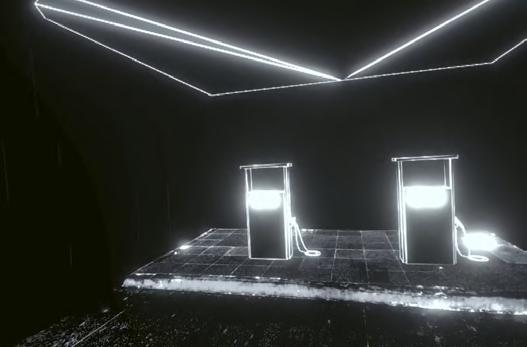
them wearing her father’s clothes and brushing her hair. In these images, the truth claim of the photograph is diminished by the impossibility of ever photographing Moisés. These speculative images become a new kind of archive, one that through its unobtainability, grasps the threads of hope that imperfectly accompany grief.
Voice is central to several works that unpack the lived experience of complex mental health journeys. The felt Experience & Empathy Lab (fEEL) presents three works under the project title ‘Spaces between people’ that translate mental health research into creative forms by giving agency and voice to ‘experts’ with lived experience. The immersive video installation work, We’re just gonna call it all BPD, brings to life the raw, intense and visceral experience of a diagnosis of Borderline Personality Disorder (BPD) with verbatim narratives of lived experience conveyed by actors. BPD, which is one of the more controversial mental health diagnoses, is alternatively interpreted as an understandable response to trauma. In dialogue with this work is A Safer Place? Stories from the Emergency Department, a virtual reality installation that recreates the embodied experience of being in an emergency department, guided by eight experts with lived experience who describe the scenarios of mental distress that led to their admissions. They also offer insights into what can be done to address the shortcomings of emergency care. A powerful counterpoint to these collective expressions of mental health and diagnosis is Rebecca Moran’s work Big Grief, Big Horror. This simple video work takes us to Rebecca’s kitchen table, when she carefully and honestly shares her personal story of grief and loss when her father and brother died in a tragic murder-suicide, at the same time she had a six-month-old baby. Her story intertwines death and new life as she discusses the discomfort of grief and how unprepared we are to deal with existential realities and the silence that ensues. Dominic Redfern’s audio-visual installation noise explores the commonalities and difficulties of conveying the experiences of depression. This work draws on a research archive of interviews with people with severe post-natal depression or major depressive disorder.
Archives of Feeling 15
A fEEL production in collaboration with RMIT University, A Safer Place? Stories from the Emergency Department (still), 2022, virtual reality for Quest2. Image courtesy of fEEL.
noise offers a mix of distortion and deeply felt realism that brings the archive to life and creates an experiential encounter for the audience.
Julie Watkin’s creative practice of photomontage engages with trauma using devices of narrative, mythology and contemporary cultural references to the femme fatale. The central premise of her life’s work is implicitly acknowledging that traumatic experiences both permanently mark us and make us. The collage in the exhibition, Pandora Series 2: Adolescent Pandora; Pandora becomes a vamp, no (i), inverts and retells the Greek story of Pandora, reclaiming this character’s agency and power and transforming her from threatened victim into mysterious threat. The engagement with text and identity is further unpacked through Jenny Hickinbotham’s exploration of the Cunningham Dax Collection — a collection of artworks created by people who have a lived experience of mental distress or psychological trauma. In 2022, Hickinbotham researched the knowledge held within this collection, exploring how careful engagements with the archive could amplify the practices of artists in the collection. By counterpointing a self-portrait and poem by Graeme Doyle with her own self-portrait and song lyrics, Hickinbotham begins a conversation with the late artist—not one that is spoken, but one that is drawn, written and sung. In addition to her response to this archive, Hickinbotham also shares with us another playful archive — a board game informed by her lived experience where we are invited to play our way through both the good days and the bad.
The artists in Archives of Feeling intervene in the idea that trauma is separate from daily life — with many grounding their experiences of trauma in the structures of colonialism and its institutions. As survivors of colonial violence, intergenerational trauma, institutional care, incarceration, medical systems, childhood abuse, discrimination, political struggle, mental distress and overwhelming moments of horror and personal grief, these artists provide significant insights into both the complexity of their own lived experiences, and the political and social conditions that
perpetuate trauma. The artworks and artists featured in this exhibition do not reflect the full spectrum of trauma experiences and knowledge; we accept that this is just a fragmented snapshot of lived experiences, situated deliberately within a local community of artists, peers and colleagues with shared interests in the social implications of trauma. We called on this community for advice and guidance in designing the content notifications and the invitations to engage compassionately with the content in the exhibition. For many in our community, this kind of sharing has been treated as a marginal or even radical act — the subtext being that mental health and trauma are subjects that should not transgress the (invisible) borders that keep their discourses strictly private or medical.
Although the artists in this exhibition offer multiple entry points into the broad topic of trauma, we recognise that it is not easy to make work about personal and systemic trauma. This kind of truth-telling is labour and, while it is also a form of resistance, it can be painfully experienced. We thank the artists of this exhibition for sharing their experiences, work and knowledge in the hope that their contribution will rupture silences, invite connection and hold institutions and systems to account.
While trauma, archives and feeling might seem an unlikely combination, most people have experienced, inherited or witnessed experiences of this grouping. This exhibition intends to expose this intersection — an intersection that becomes the ‘hinge’ between the systems and events that create trauma and the felt experience of them. In doing so, we hope to expand or recalibrate understandings of the archive and to bring to the fore creative engagements with lived experience.
16
Archives of Feeling 17
Archives of Feeling: Sensation, Connection, Community
RMIT Design Hub Gallery
19 AUG — 8 OCT 2022

Che-Wei Chen, The Children’s Sensorium, Ngaanyatjarra Pitjantjatjara Yankunytjatjara Women’s Council Aboriginal Corporation, The Nurses and Midwives Art Exchange and Thembi Soddell.
The Children’s Sensorium includes works by Tamara Borovica, Heather Hesterman, Fiona Hillary, Live Particle (Angela Clarke and Camilla Maling), Philip Samartzis, Playbour Inc. (Larissa Hjorth), Anna Schwann and Hiromi Tango (with assistance from Moon Girle), with leading artistic direction from Boonwurrung elder N’arweet Carloyn Briggs, with designs by Anthony Clarke (Bloxas), and with wall and ceiling design drawings by Artis Clarke, Skye Nguyen and John McLeod.
The Nurses and Midwives Art Exchange includes works by nurses and midwives who have worked through the pandemic accompanied by works created by local artists.
Installation image of The Children’s Sensorium. Image courtesy of the artists and their representatives.

19
Archives of Feeling
above: Installation image of The Children’s Sensorium. Image courtesy of the artists and their representatives.
opposite page, top: Heather Hesterman, Plantbathing Lab, 2022, plywood, recycled crates, LED grow lights and plants. A part of The Children’s Sensorium. Image courtesy of the artist.

opposite page, bottom left: Playbour Inc. (Larissa Hjorth), Mobile PlayStations, 2022, interventions, wayfaring and workshops. A part of The Children’s Sensorium. Image courtesy of the artist.
opposite page, bottom right: Live Particle (Angela Clarke and Camilla Maling), Soma Score and Embodiment Tools, 2022, tea-tree wood, greywacke stone, rawhide leather, up-cycled lycra, wool, cane, paper and ink. A part of The Children’s Sensorium. Image courtesy of the artists.
20
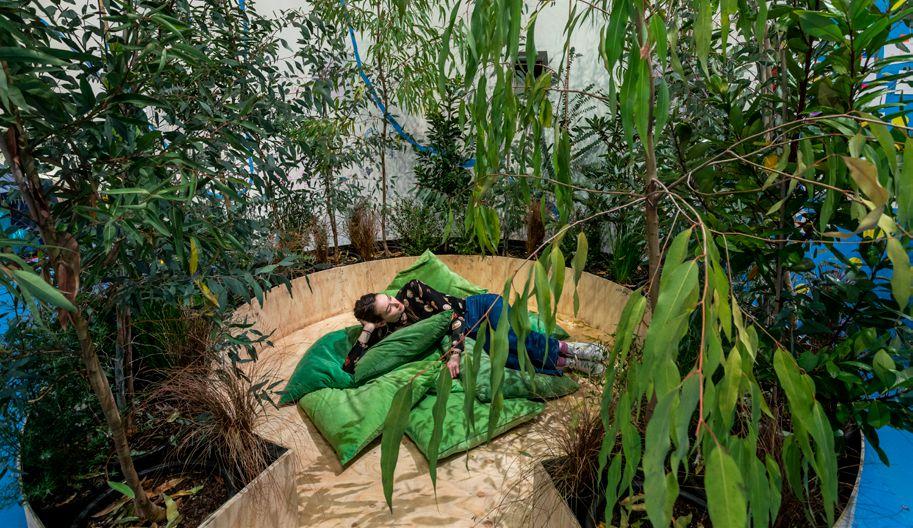

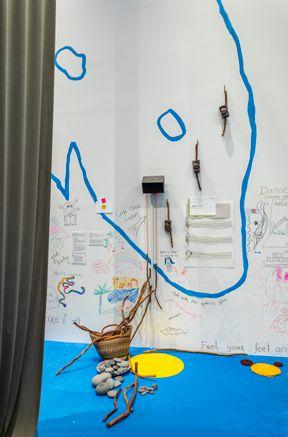
Archives of Feeling 21
Anna Schwann, Sky Charms (desert) (detail), 2022, paper pulp, bioplastic (gelatine, water, food colouring), air-drying clay, wire, spray paint, timber beads, synthetic scent (cinnamon bun). A part of The Children’s Sensorium. Image courtesy of the artist.
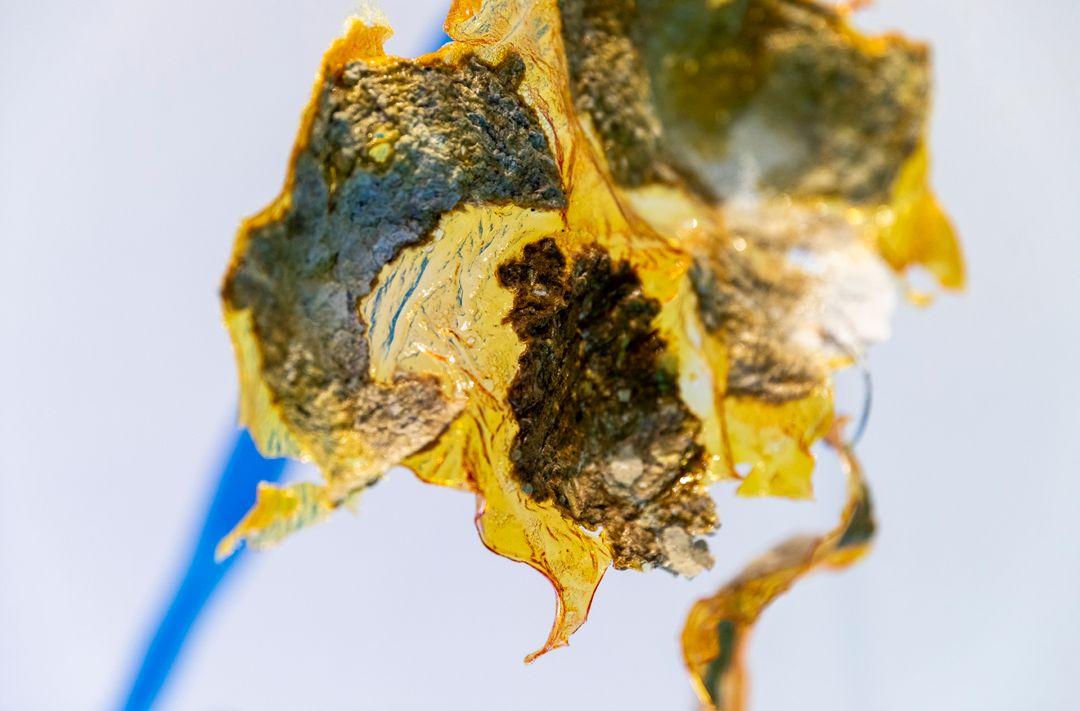
22
top

bottom


Archives of Feeling 23
left: Installation image of The Children’s Sensorium. Image includes works by Fiona Hillary, Anthony Clarke (BLOXAS) and Philip Samartzis. Image courtesy of the artists.
right: Yaluk baluk weelam, an installation of The Children’s Sensorium which includes the following works – Philip Samartzis, Tracing Time, 2022, multichannel sound composition. Hiromi Tango, Hiromi Hotel : INHABITANT, 2022, interactive mixed-media installation with netting, rope and aluminium tube frame. Image courtesy of the artists and their representatives. Photograph by Xueying Fu.
right: Drawing activity in The Children’s Sensorium. Photograph by Xueying Fu.

24
Ngurrak weelam, an installation of The Children’s Sensorium which includes the following works – Philip Samartzis, Tracing Time, 2022, multichannel sound composition. Hiromi Tango with assistance from Moon Girle, Hiromi Hotel : INHABITANT, 2022, interactive mixed-media installation with foam, fabric, rope and aluminium tube frame. Image courtesy of the artists and their representatives.
Yaluk-ut weelam, an installation of The Children’s Sensorium which includes the following works – Philip Samartzis, Tracing Time, 2022, multichannel sound composition. Hiromi Tango, Hiromi Hotel : INHABITANT, 2022, interactive mixed-media installation with fabric, foam, yarn, cloth, rope, steel mesh and aluminium tube frame. Image courtesy of the artists and their representatives.
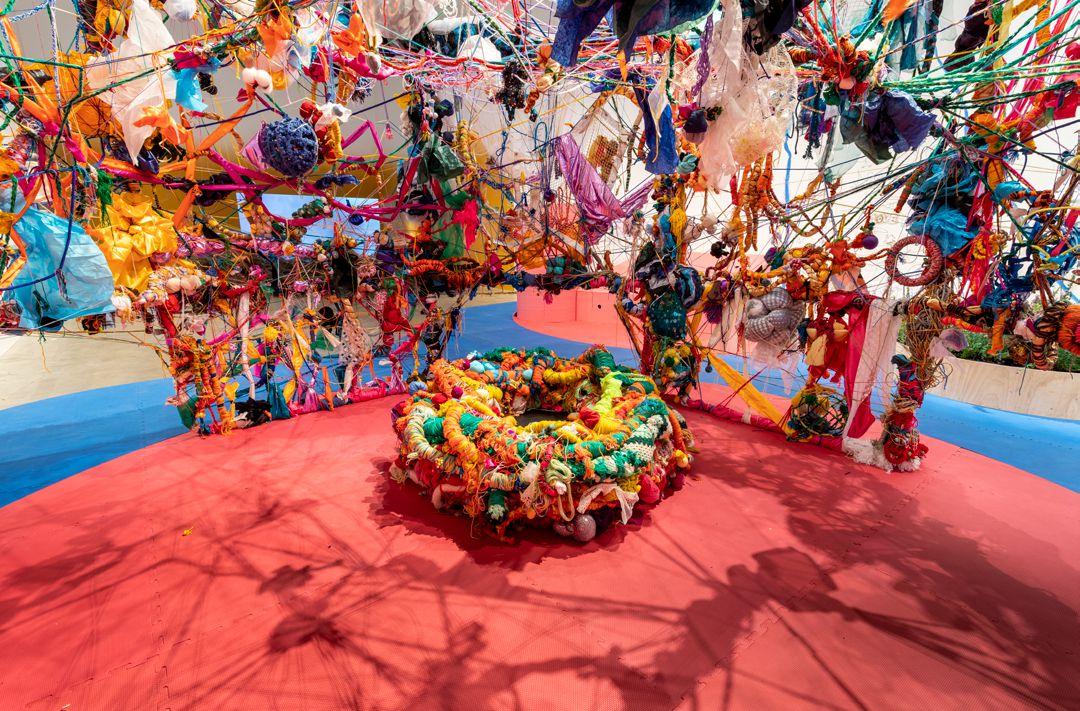
Archives of Feeling 25

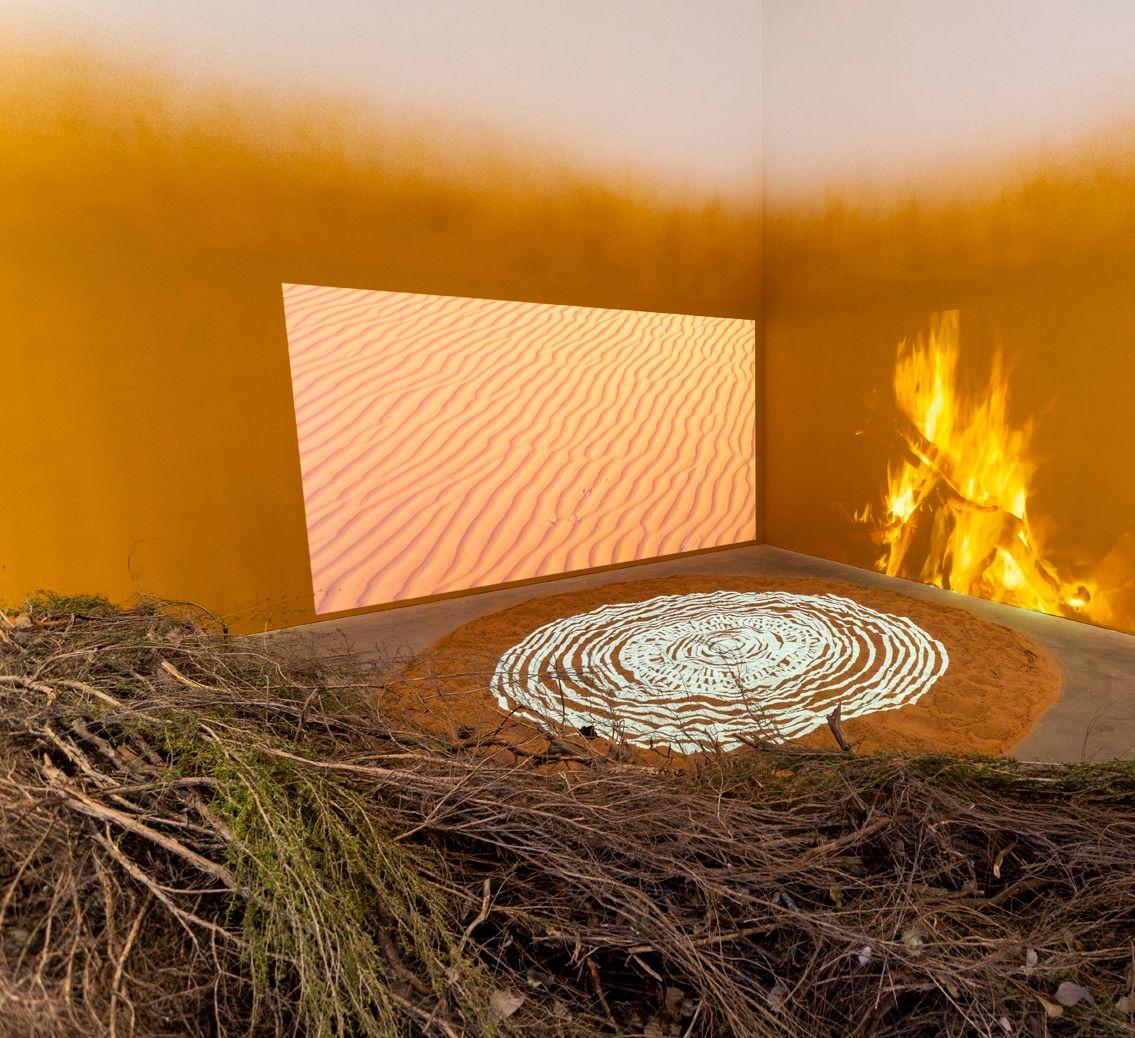
26
Uti Kulintjaku collective, Yuu, 2022, digital video, sound and mixed-media installation with earth, wood and paint. Camp fire video courtesy of PAW Media and Communications. Image courtesy of the artists and NPY Women’s Council.
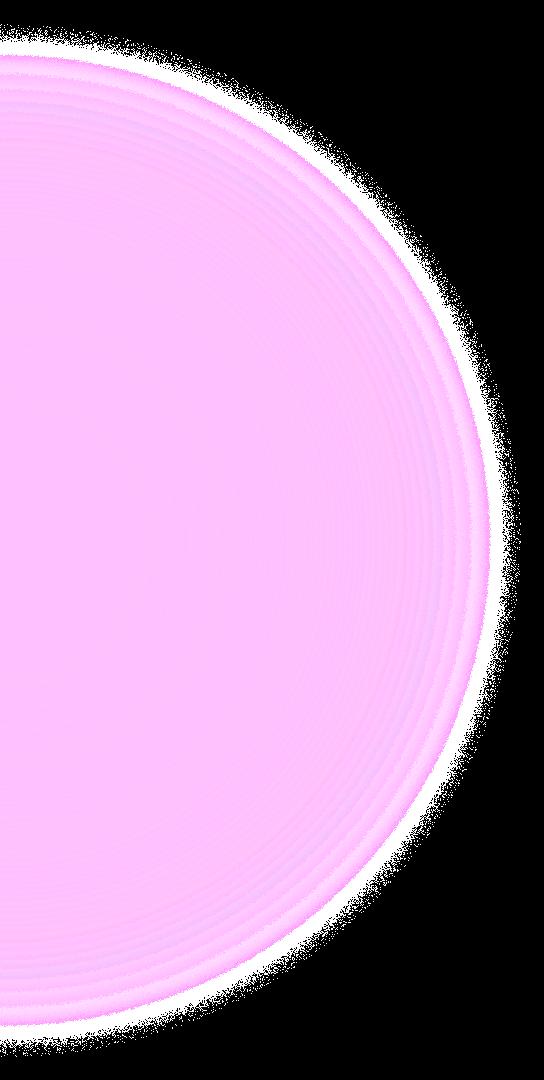

27
above: Uti Kulintjaku collective, Yuu (detail), 2022, digital video, sound and mixed-media installation with earth, wood and paint. Camp fire video courtesy of PAW Media and Communications. Image courtesy of the artists and NPY Women’s Council.
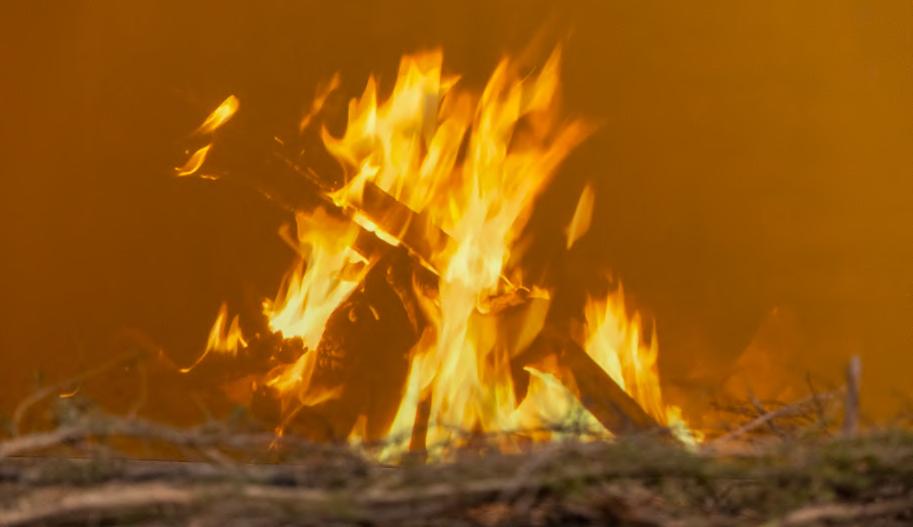
right and opposite page, bottom: : Uti Kulintjaku collective, Uti Kulintjaku — To listen and understand clearly (still), 2018, digital video meditation with English subtitles. Video by Anna Cadden. Image courtesy of the artists and NPY Women’s Council.
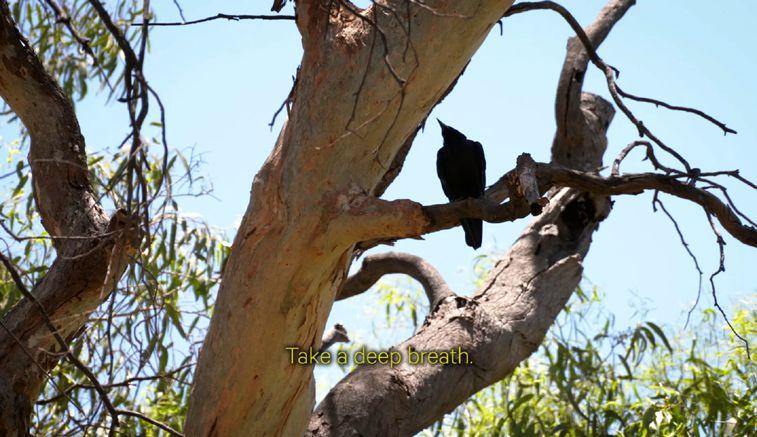
28
above: Uti Kulintjaku collective, Tjilku Pirni, Pitja-ya Nyinakati — Dear Children (still), 2021, video meditation in Ngaanyatjarra with English subtitles. Video footage by Robert Nugent, Fiona Walsh and Rhett Hammerton with video editing by Anna Georgia Mackay. Image courtesy of the artists and NPY Women’s Council.
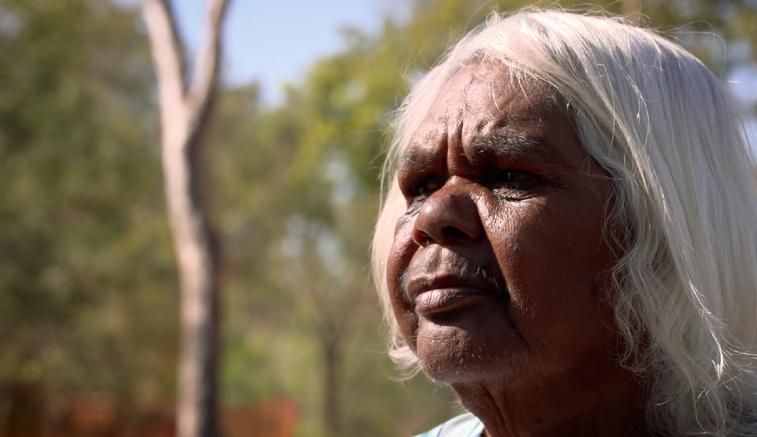
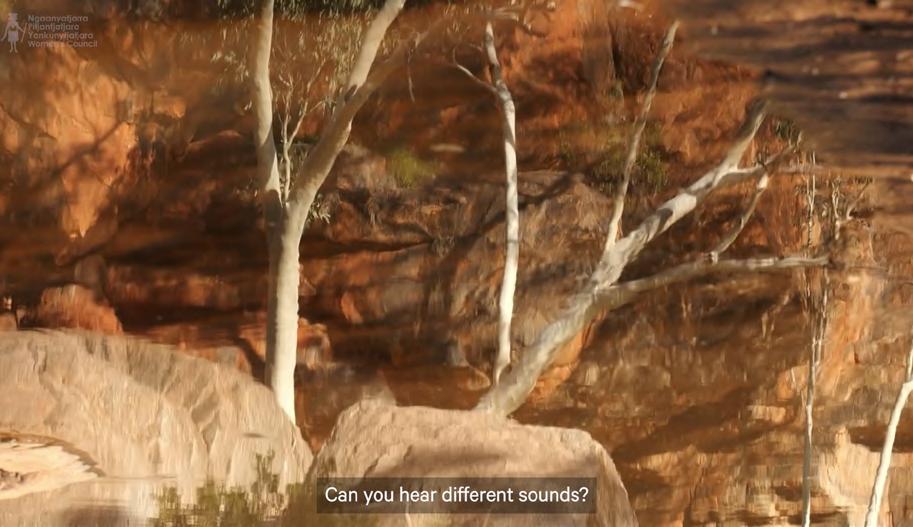
Archives of Feeling 29

30
Jessica Guo, For Danielle (detail), 2022, gouache, watercolour and graphite on paper. A part of The Nurses and Midwives Art Exchange. Image courtesy of the artist.
above: Installation image of The Nurses and Midwives Art Exchange. Image courtesy of the artists.

left: Leesha Wild, Shelter in a storm (detail), 2022, miniature, clay, balsa wood, felt and wire. A part of The Nurses and Midwives Art Exchange. Image courtesy of the artist.

Archives of Feeling 31
Installation image of The Nurses and Midwives Art Exchange. Image includes the following works – Mim Johnson, Teardrop, 2021, ceramic vessel. Koa Wamsteker, Catching Your Teardrops, 2022, ceramic. Image courtesy of the artists.
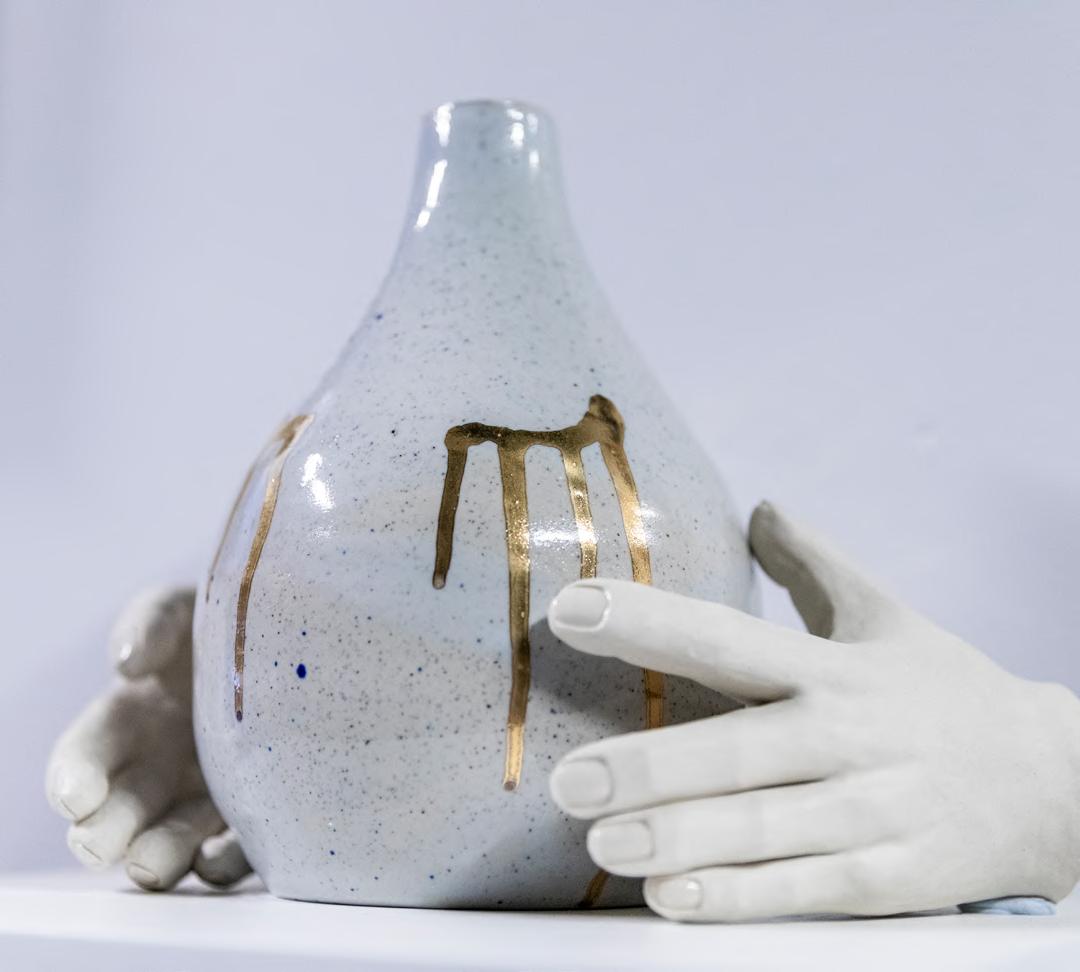
32

Archives of Feeling 33
Alice Jordan, my working hands (detail), 2022, re-purposed leather jacket, plastic gloves and embroidery thread. A part of The Nurses and Midwives Art Exchange. Image courtesy of the artist.

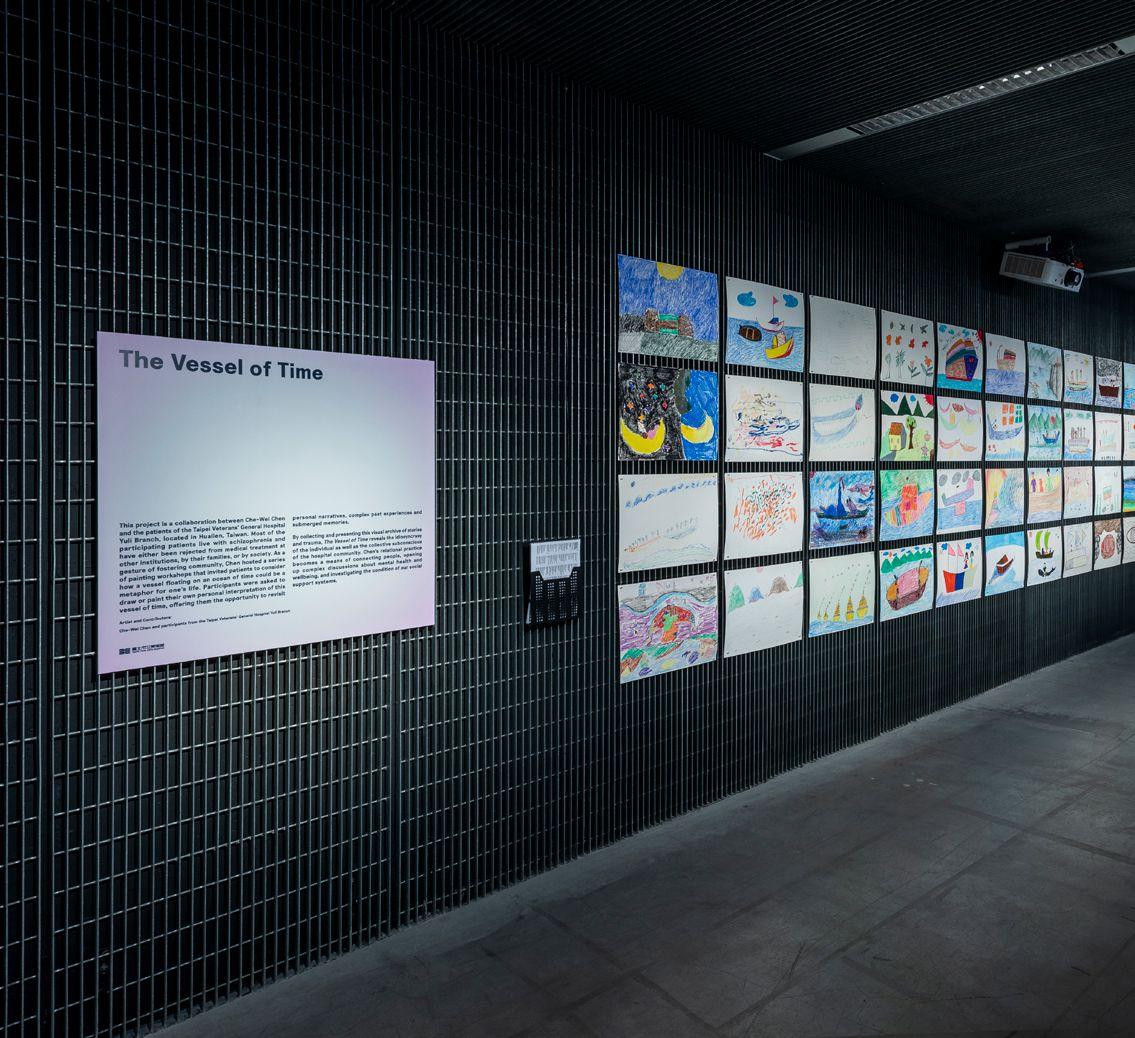
34
left: Che-Wei Chen with the residents of the Taipei Veterans’ General Hospital Yuli Branch in Hualien, The Vessel of Time (I) and (III), 2017, drawings and single-channel video installation. Image courtesy of the artists.


bottom right: Hsian Shen Mei, Demon Boat, 2017, drawing. A part of Che-Wei Chen, The Vessel of Time (I), 2017. Image courtesy of the artists.

35
above: Che-Wei Chen, The Vessel of Time (III) (still), 2017, single-channel video installation. Image courtesy of the artist.
opposite page, top: Li Li, A Boat in the Wide Ocean, 2017, drawing. A part of Che-Wei Chen, The Vessel of Time (I), 2017. Image courtesy of the artists.
opposite page, bottom: Sandy Chin, A Boat to Our Future: World in One, 2017, drawing. A part of Che-Wei Chen, The Vessel of Time (I), 2017. Image courtesy of the artists.

36
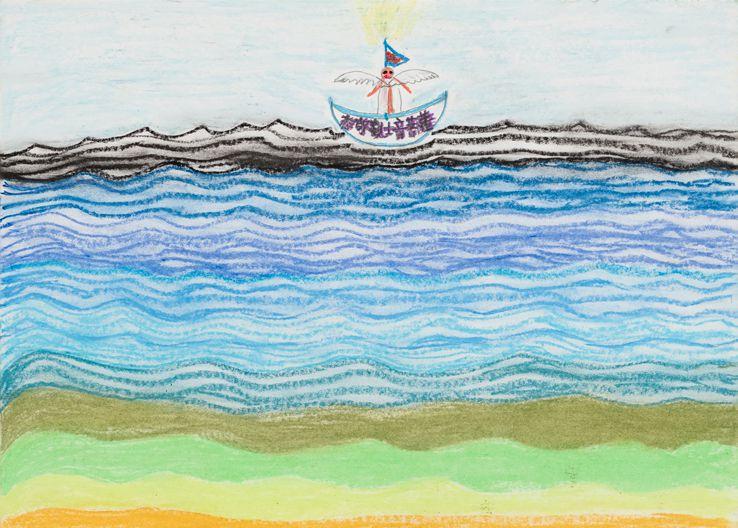
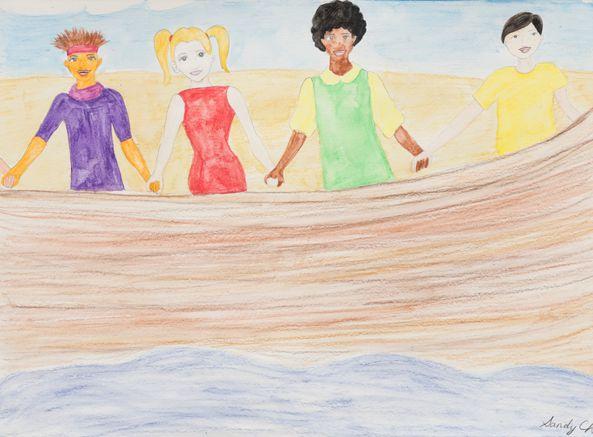
Archives of Feeling 37

38
above and opposite page: Thembi Soddell with design by remi cady freer, Who is Doing What to Whom? (Object Impermanence), 2022, steel, aluminium, EchoPanel, speakers, subwoofers, wheelchair, printed book, journal, 14.2 channel sound. Image courtesy of the artist.

Archives of Feeling 39
Beyond the Fringe
by Brian McKinnon
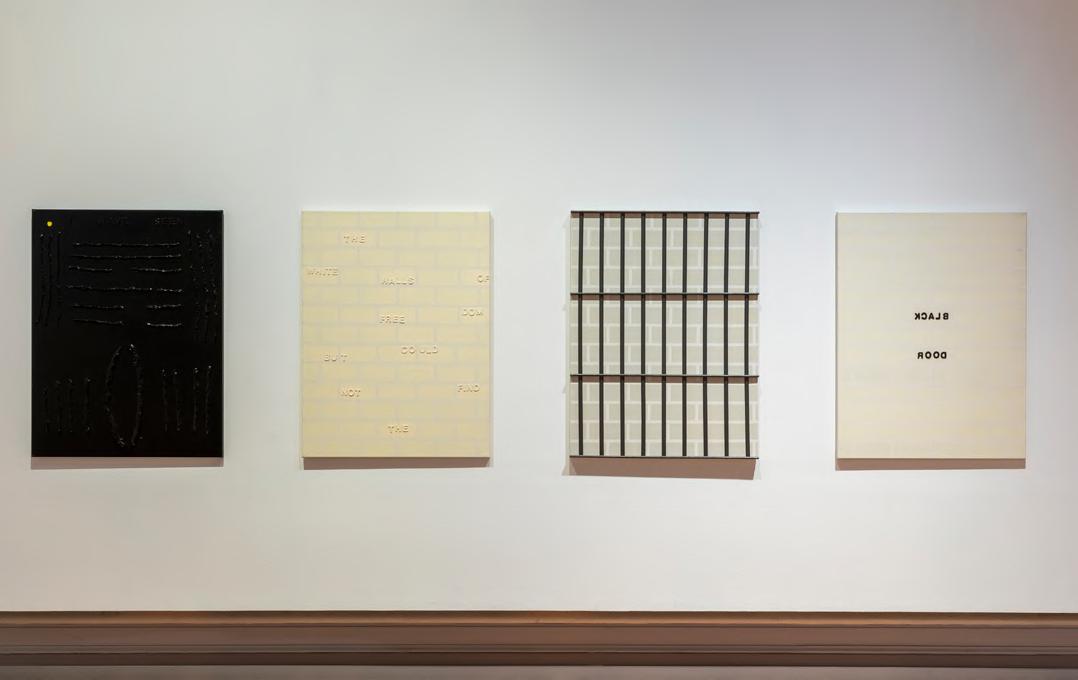
40
Brian McKinnon, The White Walls of Freedom, 2015, acrylic, wood, foam letters, liquid nails, on canvas. Image courtesy of the artist.
I was born into a contemporary society, therefore my thought process and my work is dominated by contemporary movements of the day. My interpretation of today’s societal thought is that when tourists and white Australians hear the word Aboriginal, they immediately think black people. Today’s Aboriginal comes in many shades, including white. I am a white Aboriginal with a strong traceable bloodline. I choose to live a contemporary Aboriginal oriented life. In this, I draw from my Aboriginality and the penal lifestyle forced upon me by my white ancestors.
Therefore, it’s between the two that I must carve out a place where I can be at one with both and myself. Being Aboriginal is not defined by colour, it’s much more than skin hues. It’s a sense of being it’s a spiritual connectedness to country and a memory, my memories although cultural, have a very contemporary approach, it’s who ‘I AM’ and I don’t need permission from either culture for who I am. I respect both and try to follow their direction, the cultural and spiritual aspects of the Aboriginal heritage is stronger, and are adhered to more so than the white. My life will remain as a contemporary Aboriginal, in a confusing world.
My use of art to engage with the world is a deep internal struggle that stems from my early years and the eventual need to run to survive. The paintings show a journey of pain, and the pain caused by racism and lack of compassion or charity for a group of people, lost on their path to becoming accepted for who they are. My work reflects on my travels as I am one of these people caught between two races where up until now have ignored my existence. My work I hope will enlighten the audience a little and expose myself to the viewer. In my work, I like to try and emulate my feelings at the time of creating,
Could you abide
Another maker of your own creations?
And should I be content to be the brush When I could be the artist? I think not.1
During my stay at Blood Alley and my life after Blood Alley there have been several very strong WOMEN that have shaped my life. These include my mother whom for the life of me could not abide each other, my Aunties several of them being stolen generations, their stories in part will be included, and of course my wife and daughter, there has never been a male role model to influence my life other than those who have had brief contact with my memories. My brothers and sisters have only shared a very small portion of my journey and memory as I was in part restricted from contact with them by our parents and a good piece of my memory says that during their lives I spent mine incarcerated. During their adult lives they had their own journeys and memories to construct. My blood father I will never meet he died making this impossible.
The struggle for ownership, any boundary’s and the mark making is for others, I need to carry mine with me. My territories, my song lines are hidden in my paintings so to leave them behind is to expose myself to the enemy those who hunt and trace me. My travels and deeds are only for people I trust and at this moment I am sharing a portion of that privacy with a broader audience. I admire people who try for a reclamation of territories and culture. My idea of walking softly on this land is to have those territories in my mind, outside of Blood Alley they are the only thing I possess and if someone were to discover them they may take them as their own. To leave my mark on someone else’s land is abhorrent to me, one of the greatest insults to those who reside there. It would mean I was trying to take from them something held dear to them, so to leave my mark and let my presence be seen is an act of war a direct challenge to ownership.
I paint my memories on canvas, even this method is sometimes a drawn-out struggle between my willingness to share and my need for privacy. Some memories are easy to share others are a violent struggle between emotion and a need to expunge all of the festering past, the past that
Archives of Feeling 41
1 Peter Conrad, Creation: Artists, Gods and Origins (London: Thames & Hudson, 2007), 273.
haunts me, taunts me exposes me in ways that others can only imagine. These throws of pain I hope are revealed in the methodology and materials used in my studio practise. My canvas and my paint are my idea of my own personal graffiti, I leave a transient mark (scratch, graffiti) on someone’s wall a memory they can take with them. They can place it on another wall that has meaning for them and helps I hope in their transition from one place to another. In this way I am not responsible for the transgression from one to another. I am in a way anonymous it is they who leave my mark (graffiti) on the wall for a time in that place there is a memory and through my canvas and paint I was there. Are these the rantings of a fool too old to reason, I sometimes feel like I’m throwing paper pebbles at the sun.
Whilst other Australians prepare for their great party who will remember our fallen? As the champagne and the beer flows who will think of chains and poison, of guns and the lash, the dreaded “Native Inspector” come to take the children away to become servants for the Gubbah. Will they think of living on the road and living under the bridges, of dispossession, of fences and the “keep out” signs, of pass laws and of that cruel joke of 1967 “Citizenship”?
Surprisingly, through the bitterness comes other feelings, relief and joy, the knowledge that we have survived –damaged yes, but not disintegrated. An artist is in a unique position, able to look at the past, the present and the future, able to keep the old traditions alive and inspire others around them to create new ones. The road to equality and self sufficiency is hard and long. Sometimes I think I can see a glimmer of light off on the horizon, if I ever get there I know other artists, my peers will be there too.
While others are having their Bi-centennial parties, their fireworks displays and their pioneering re-enactments – spare a thought for the vanquished. My people will be doing as they have always done, quietly persevering and
2 Lyn Onus, Art & Aboriginality (exhibition catalogue, 1987).
surviving, surely we have another 200 years of hard work ahead of us.2
42
Archives of Feeling 43
Archives of Feeling: Trauma, Knowledge, Empathy
RMIT Gallery
21 SEP — 10 DEC 2022
 Rushdi Anwar, Peta Clancy, Maree Clarke, Graeme Doyle, UNSW fEEL Lab, Julie Gough, Jenny Hickinbotham, Brian McKinnon, Rebecca Moran, Dominic Redfern, Mariela Sancari, T-collective and Julie Watkins.
T-collective includes Simon Crosbie, Mig Dann, Yi Won Park and Jude Worters.
Rushdi Anwar, Peta Clancy, Maree Clarke, Graeme Doyle, UNSW fEEL Lab, Julie Gough, Jenny Hickinbotham, Brian McKinnon, Rebecca Moran, Dominic Redfern, Mariela Sancari, T-collective and Julie Watkins.
T-collective includes Simon Crosbie, Mig Dann, Yi Won Park and Jude Worters.
Jenny Hickinbotham, Déja Vu all over again (detail), 2017/2022, paper and acrylic paint, dice, moving tokens, gum nuts, photographs, cars, cards. Image courtesy of the artist.
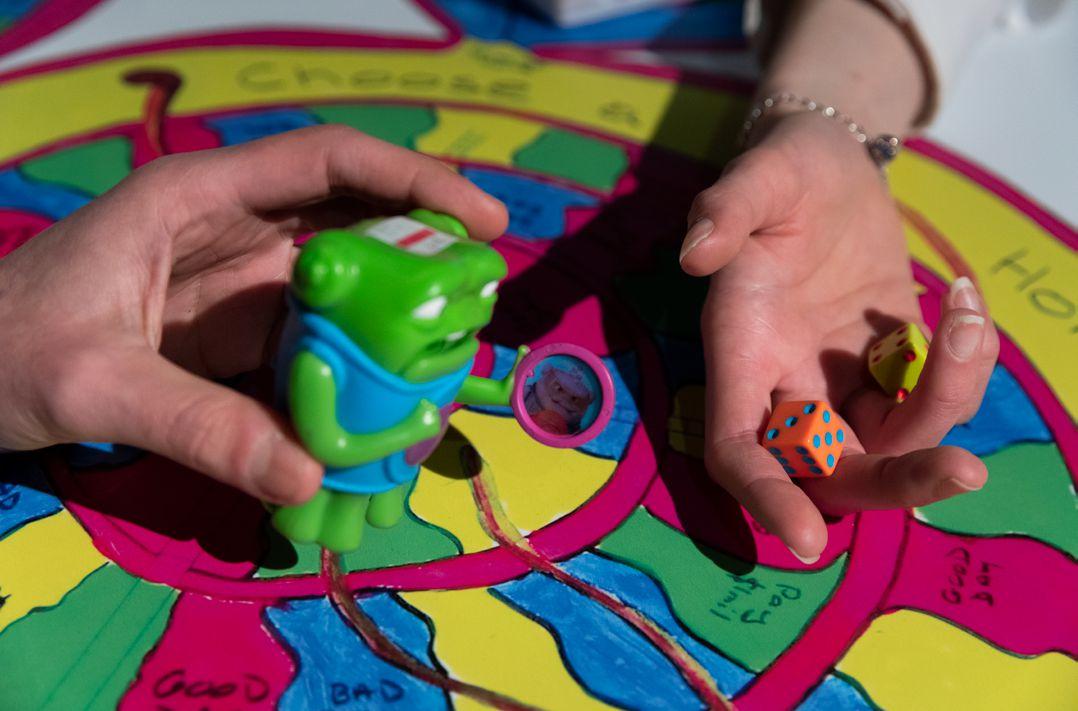
Archives of Feeling 45
above and opposite page: Rushdi Anwar, We have found in the ashes what we lost in the fire, 2018, mixed medium and wooden box. Image courtesy of the artist.
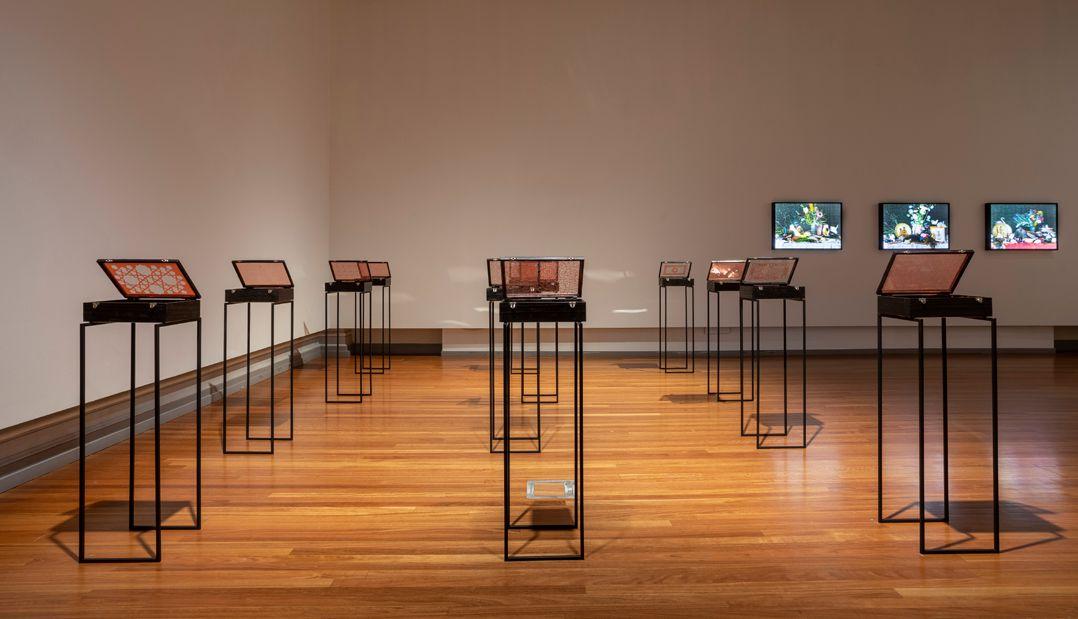
46
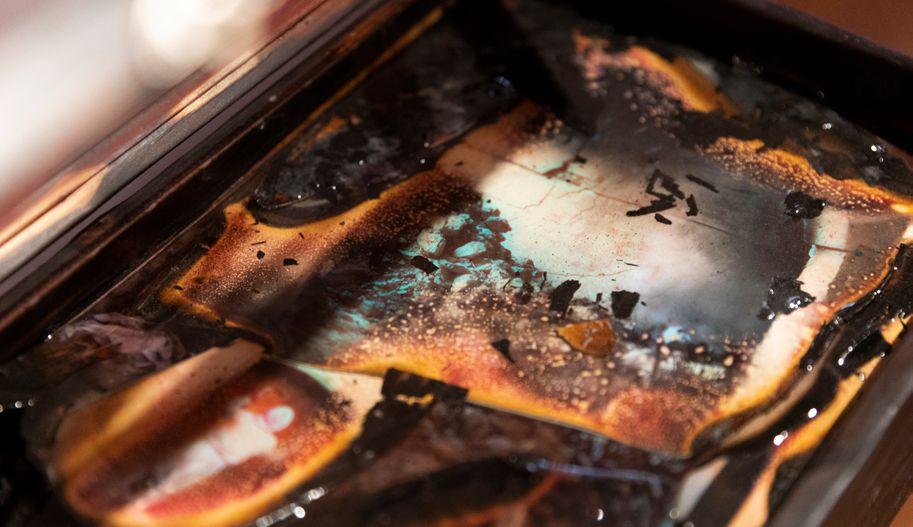

Archives of Feeling 47

48
Peta Clancy, Fissures in Time 1, 2, 3 and 4, 2017, inkjet pigment prints. Works listed from top left to bottom right. Image courtesy of the RMIT University Art Collection.
top: Maree Clarke, Made from Memory III (artwork image plate), 2020/21, image for lenticular 3D print in lightbox. Image courtesy of the artist and Vivien Anderson Gallery.
right: Maree Clarke, Made from Memory III, II, I, 2020/21, lenticular and 3D photographic light boxes. Works listed from left to right. Image courtesy of the artist and Vivien Anderson Gallery.

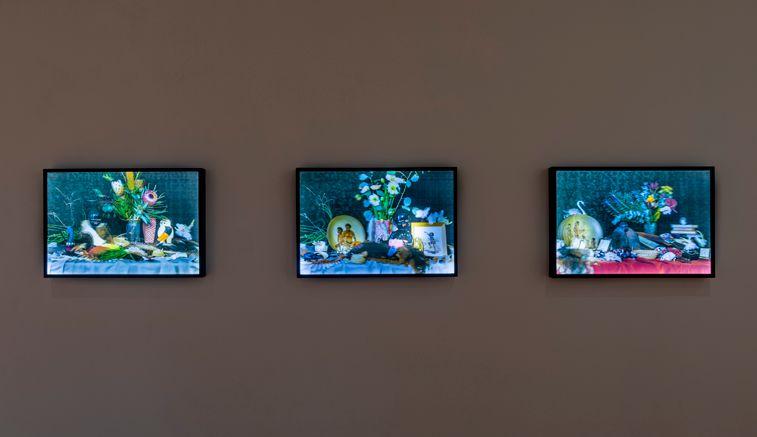
Archives of Feeling 49
above: Yi Won Park, Between Water and Light, 2022, cast resin sculpture installation. A part of the T-collective. Image courtesy of the artist.
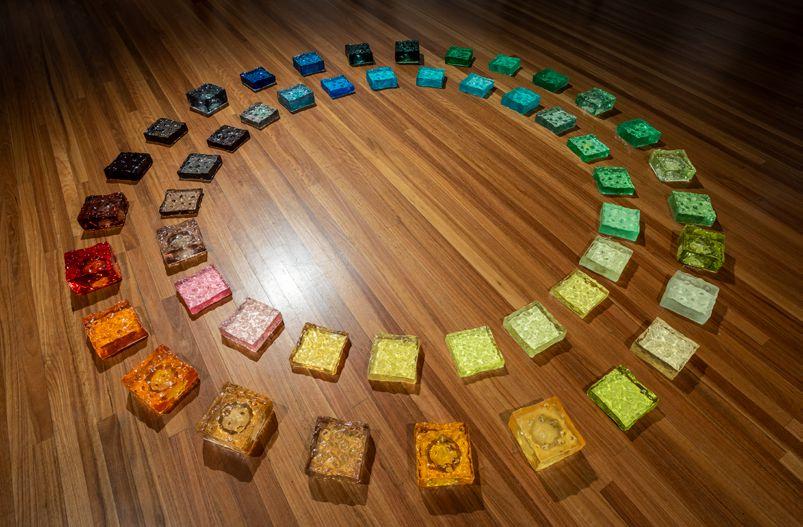
right: Installation image of the T-collective. Image includes works by Jude Worters, Mig Dann and Simon Crosbie. Image courtesy of the artists.
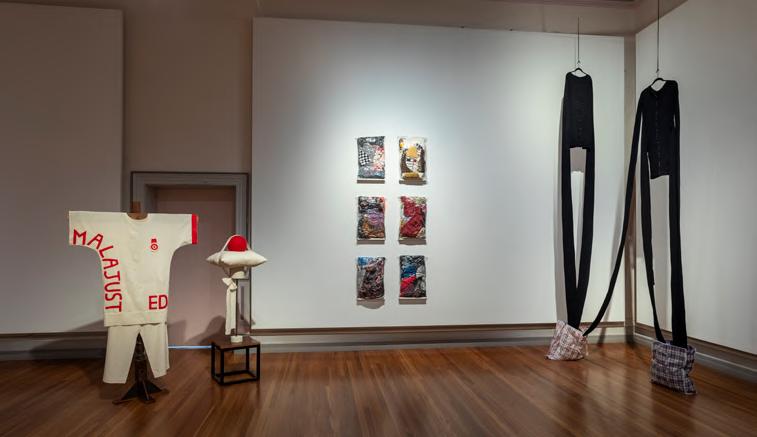
50
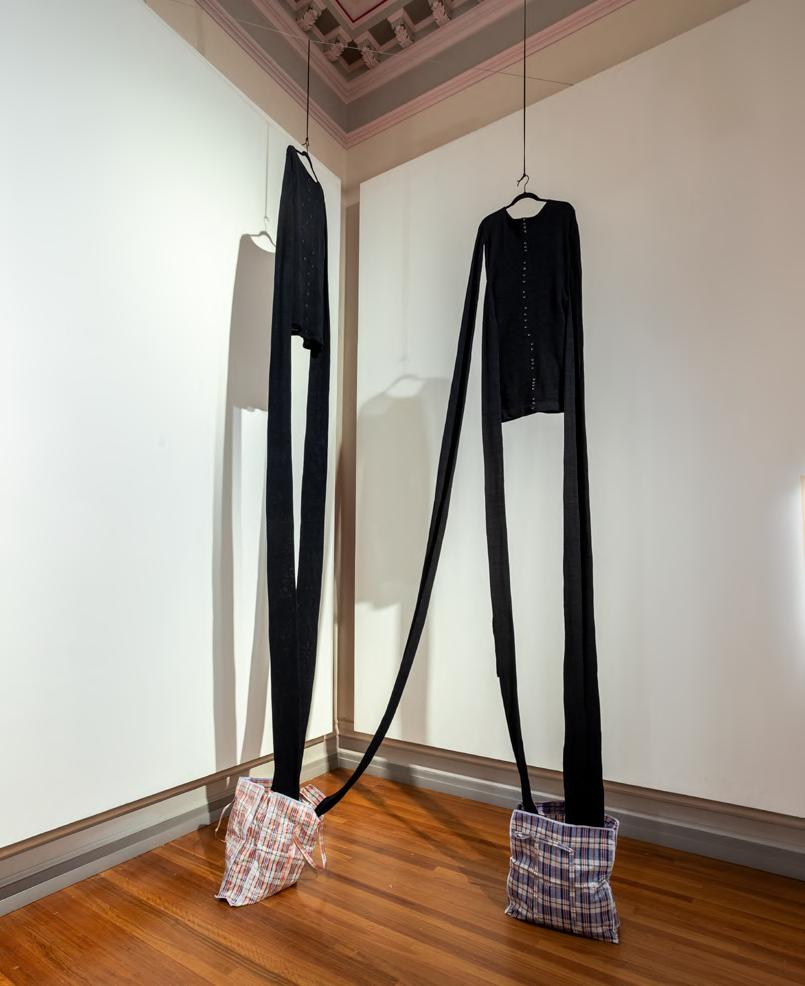
Archives of Feeling 51
Simon Crosbie, Trauma/pre-Trauma, 2018-2022, wool. A part of the T-collective. Image courtesy of the artist.
above and right: Mig Dann, Love is in the bag, 2022, worn textiles, plastic. A part of the T-collective. Image courtesy of the artist.
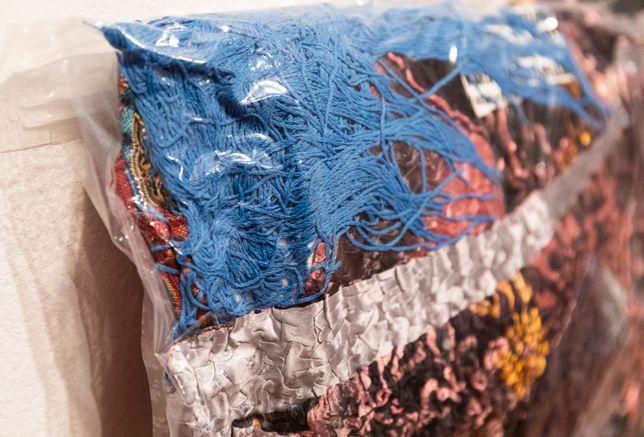

52
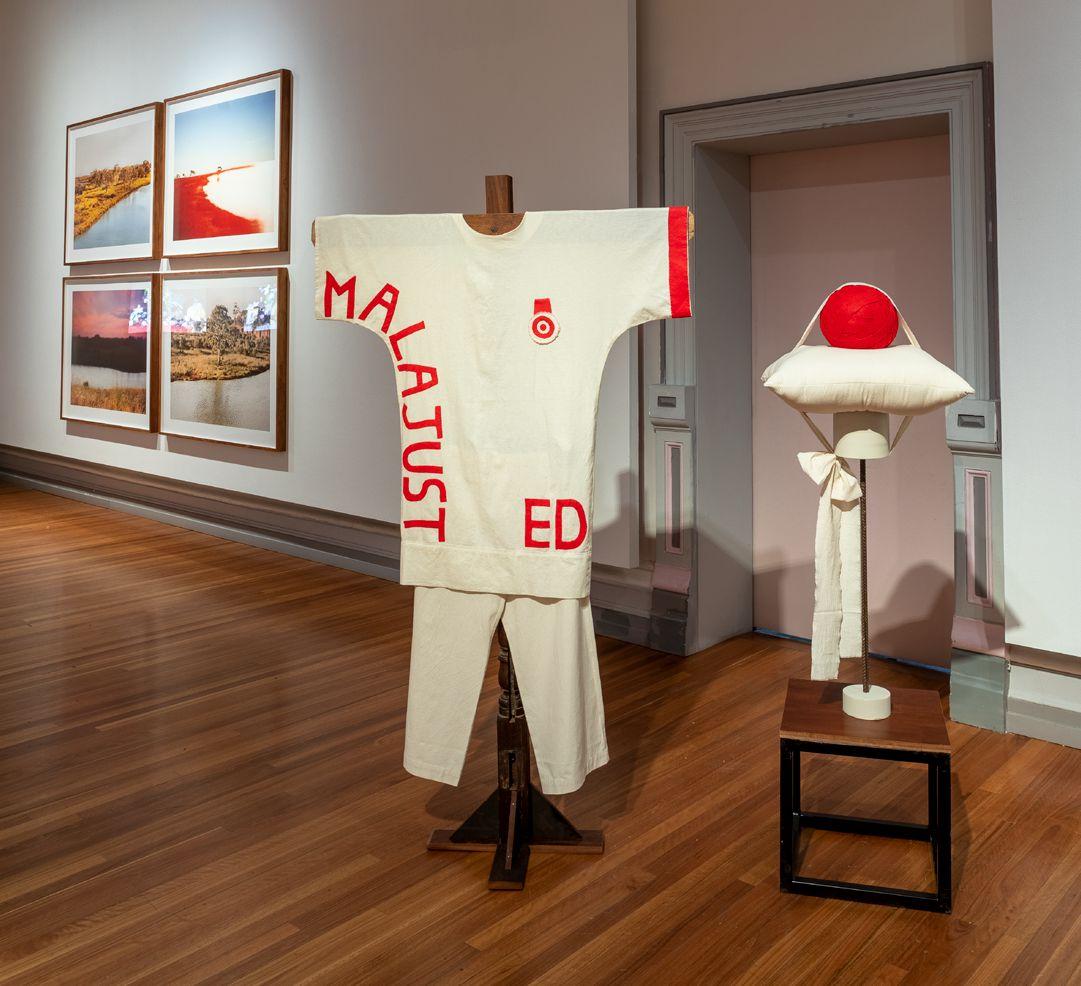
Archives of Feeling 53
Jude Worters, Malajusted, 2020/21, garment and headpiece made of calico, felt and stitching. A part of the T-collective. Image courtesy of the artist.

54
Image includes the following works – left: Brian McKinnon, In the Name of God, 2022, acrylic, cardboard, on canvas. right: Brian McKinnon, The White Walls of Freedom, 2015, acrylic, wood, foam letters, liquid nails, on canvas. Image courtesy of the artist.

Archives of Feeling 55
(i),
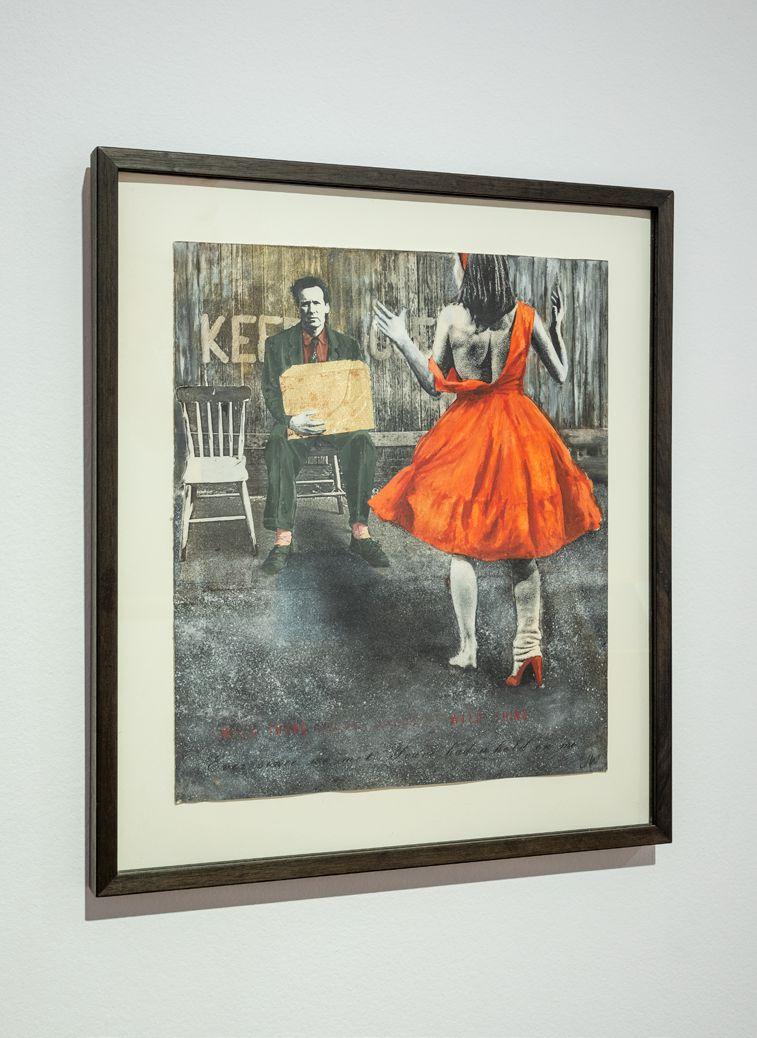
56
Julie Watkins, Pandora Series 2: Adolescent Pandora; Pandora becomes a vamp, no
1994, photo montage and gouache on paper. Image courtesy of the RMIT University Art Collection.
above: Mariela Sancari, Moisés, 2022, book (2nd edition, self published, Barcelona, Spain). Image courtesy of the artist.
left: Image includes the following works –left: Mariela Sancari, Moisés, 2022, book (2nd edition, self published, Barcelona, Spain). right: Mariela Sancari, Moisés, 2015, ink-jet prints on rice paper. Image courtesy of the artist.
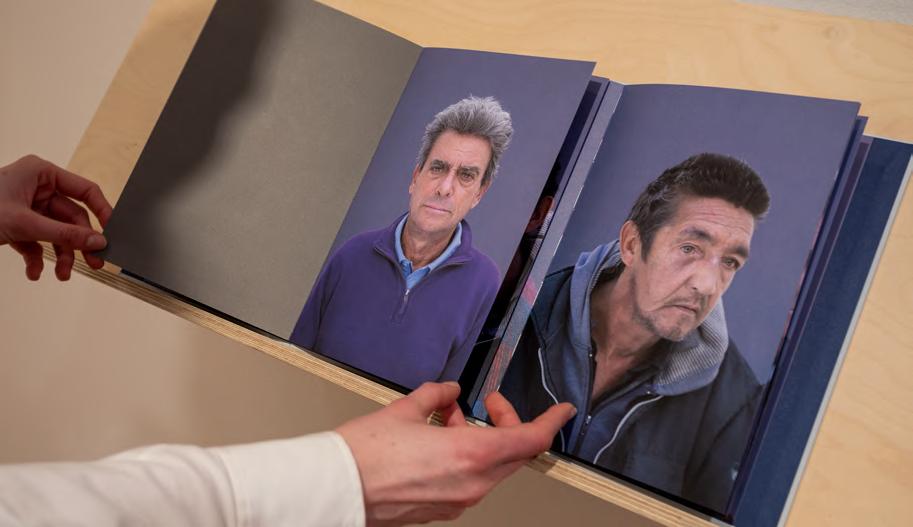
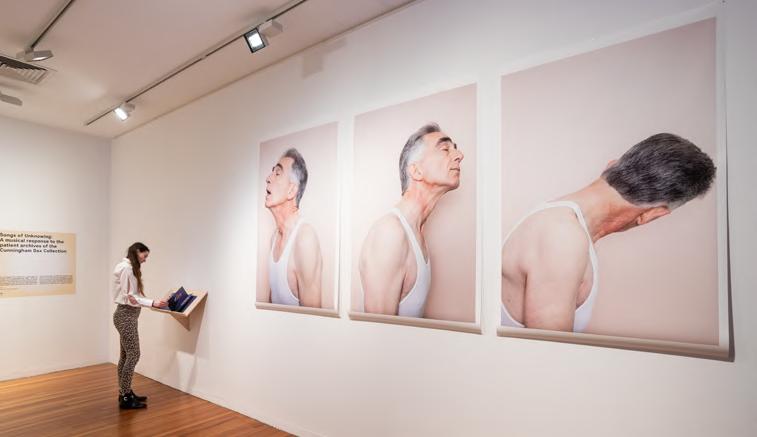
Archives of Feeling 57
Image includes the following works – left: Jenny Hickinbotham,TheSelfie myTeacherAdvisedAgainst, 2017, charcoal on paper. middle: Jenny Hickinbotham,AlltheGoodandBadDays, 2022, poem, ink-jet print on paper. right: Graeme Doyle,It’sNotaHangover,It’saGuillotineOfferYour Head, undated, photocopy, ink and correction fluid on paper. These works are a part of Jenny Hickinbotham’s projectSongsofUnknowing:Amusical responsetothepatientarchivesoftheCunninghamDaxCollection. Image of Hickinbotham's works courtesy of the artist. Image of Doyle’s works courtesy of The Cunningham Dax Collection, The Dax Centre (2004.0997).

58

Archives of Feeling 59
Dominic Redfern, noise, 2022, video installation. Image courtesy of the artist.
For the Archives of Feeling exhibition, the felt Experience & Empathy Lab (fEEL) produced Spaces between people, a grouping of three works that examine lived experiences in the spaces between inner and outer worlds – the oftenimperceptible zone, navigated by feeling and sensation, in which we experience our crushing annihilations and our transformations. Spaces between people activates an intimate environment in which the external conditions that perpetuate trauma are both illuminated and momentarily displaced as new possibilities for engagement are realised.
In We’re just gonna call it all BPD (2022) six characters reflect on the early attachments or family relationships that shaped their emotional lives, as well on living with diagnosis and stigma. This work is a collaboration that builds on research from an Australian Research Council linkage project led by Prof Renata Kokanović. Prof Kokanović’s research also underpins A Safer Place? Stories from the Emergency Department (2022), in which the inner experience of an
often-inhospitable outer world is revealed in accounts of mental health admissions to the Emergency Department. In Big Grief, Big Horror (2022), a grief of a magnitude too big to place in the world is shared.
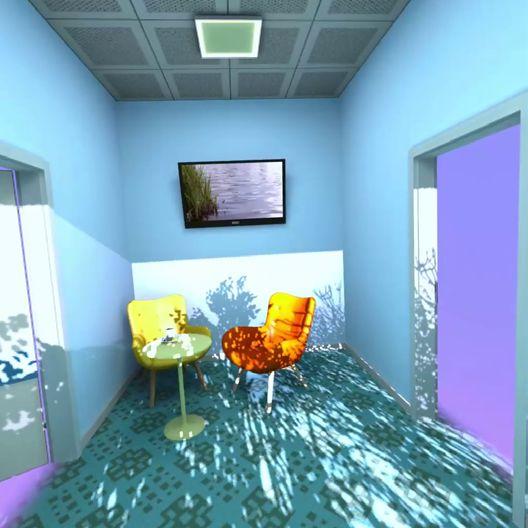
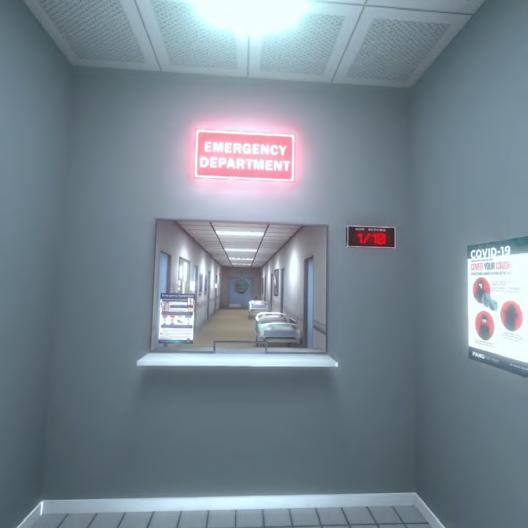
Each work presents a testimony of lived experience. They are designed to facilitate a close relationship to this experience; in other words, to create the conditions for empathy. But as the psychotherapist Carl Rogers observed, the often-insurmountable barrier to interpersonal communication is our natural tendency to judge, to evaluate, and to approve (or disapprove) the statements of others. Rarely do we engage in active listening, attuning to the internal world of another with ‘unconditional positive regard.’ In Spaces between people, we invite the audience to do so.
– Co-directors of The Big Anxiety festival, Scientia Prof Jill Bennett (Director of UNSW fEEL) and Prof Renata Kokanović (Director of RMIT Social and Global Studies Centre)
60
above and opposite page: A fEEL production in collaboration with RMIT University, A Safer Place? Stories from the Emergency Department, 2022, virtual reality for Quest2. A part of Spaces between people. Images courtesy of fEEL.
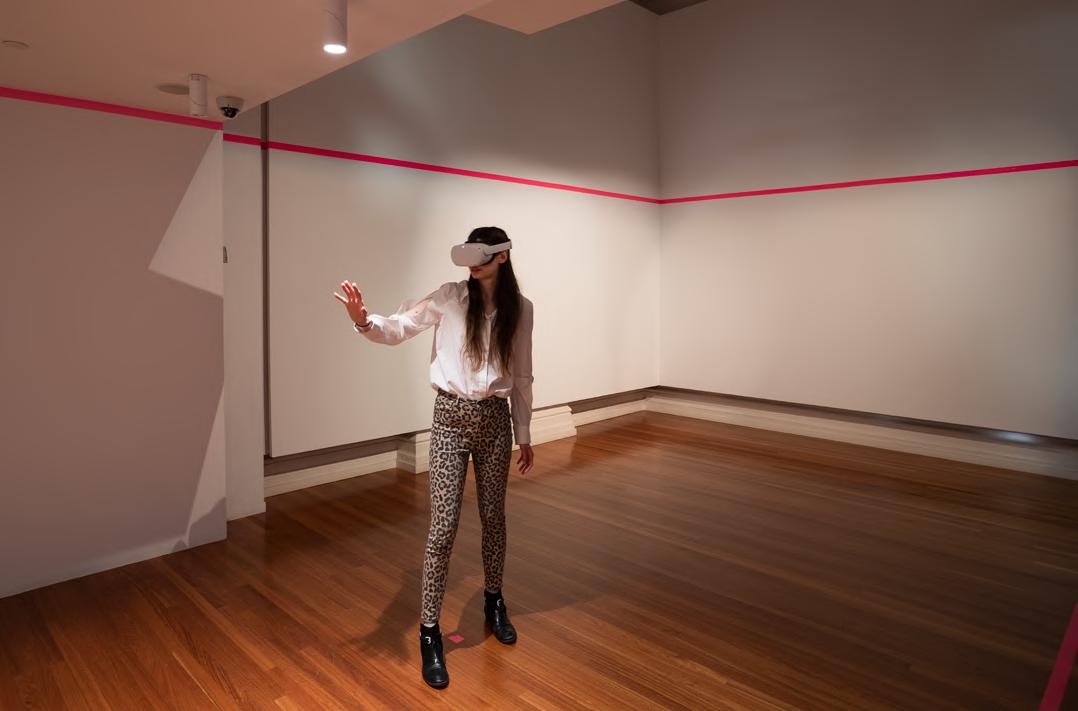
Archives of Feeling 61
A fEEL production in association with RMIT University and UTS, We’re just gonna call it all BPD, 2022, three-channel video installation. A part of Spaces between people. Image courtesy of fEEL.
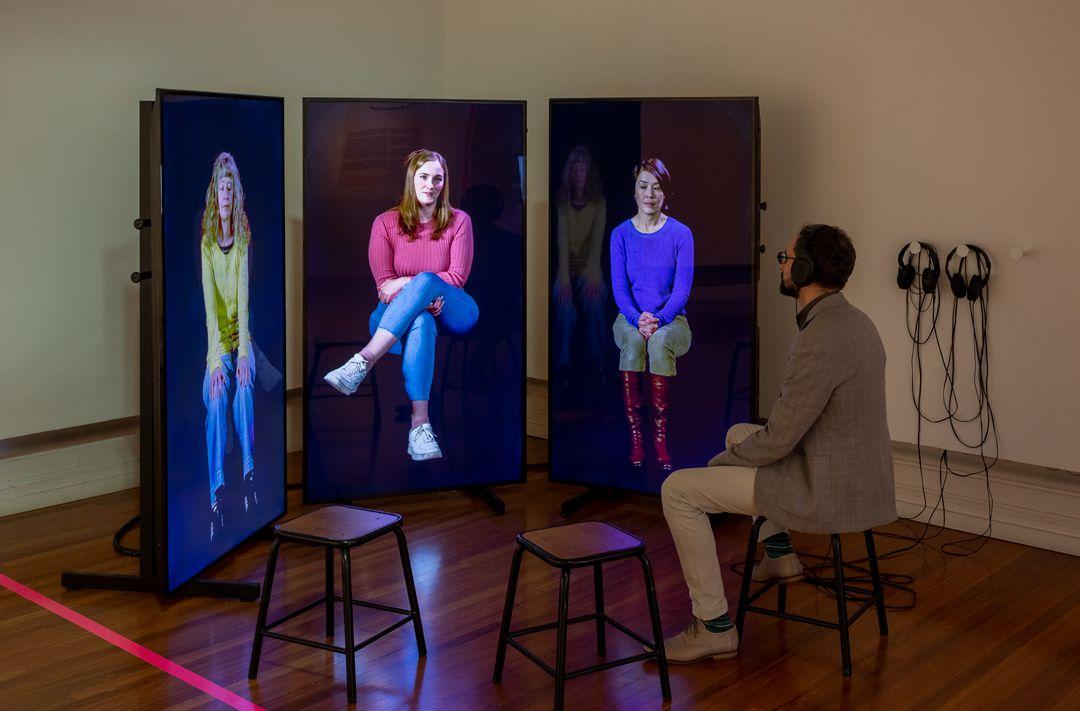
62
Rebecca Moran, Big Grief, Big Horror, 2022, single-channel video. This project is a fEEL production for The Big Anxiety. A part of Spaces between people. Image courtesy of the artist and fEEL.

Archives of Feeling 63
above

64
and opposite page: Julie Gough, THE WAIT, 2022, 4k video, sound, Paranaple (Mersey river, near Latrobe, Lutruwita/Tasmania). Images courtesy of the artist.
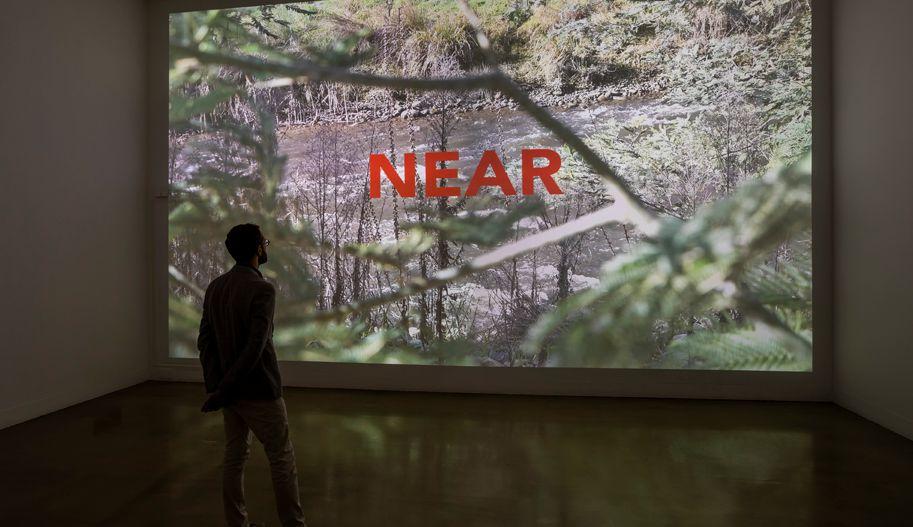
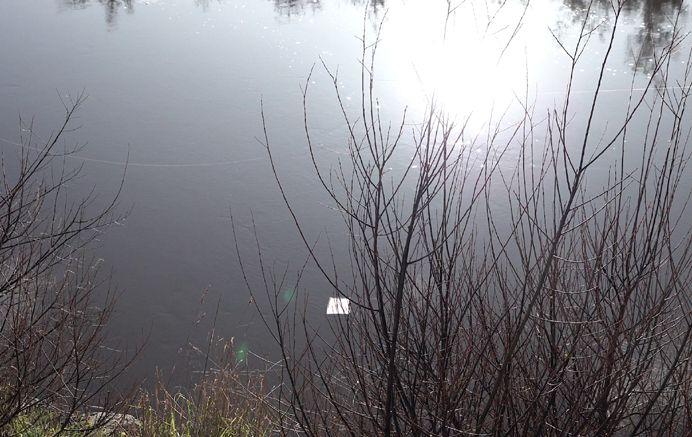
Archives of Feeling 65
From the Still Ongoing Archive of Pandemic Feelings
by Ann Cvetkovich
Preamble
I am thrilled to see my notion of “an archive of feelings” become a curatorial inspiration -- and moreover for an exhibition that responds to trauma through art and culture and by bringing together both affect and archives. My book An Archive of Feelings: Trauma, Sexuality, and Lesbian Public Cultures addressed the challenges of creating archives for both trauma and LGBTQ sexualities, as well as for feelings that are ephemeral, marginalised, or hard to access. Creative approaches to documentation are necessitated by the way that trauma, which so often escapes memory and representation, puts pressure on the archive, and artists and curators have an important role to play in facilitating new kinds of representation and new kinds of public spaces that can allow feelings to be expressed.
My contribution below is another installment in writing a pandemic archive of feelings that has emerged through my Public Feelings group, which has managed to gather by Zoom since April 2020 for monthly writing salons. My monthly 500 words have often taken the form of “hundreds,” the format used by my fellow travelers, Katie Stewart and Lauren Berlant, for their co-authored book and originally brought to our group via Circe Sturm. It’s a way of jotting down a quick take on what’s happening in the realm of the everyday or ordinary – an archive of feelings.
66
From the Still Ongoing Archive of Pandemic Feelings
The Student Mental Health Crisis
The students have been dropping like flies over the course of the pandemic. We try accommodations of all kinds in order to keep them afloat – compassionate grading, workarounds for missed classes, tests, and assignments, no requirement of a doctor’s note for excused absences, information about how to access counseling services, constant emotional availability to discuss their feelings of overwhelm and despair. But what with their COVID, their family’s COVID, their jobs, their moves, their breakups, and their panic attacks, they are barely present. The so-called pivot to teaching via Zoom was challenging, but all the more so was teaching in hybrid forms to a combination of students in the room and students online, while wearing masks, maintaining social distance, and dealing with technology fails. The students appreciated the flexibility but for me it was tedious and took all the fun out of teaching as a social exchange.
Distracti-pression
A July 2022 New York Times article called “The Age of Distracti-pression” reports that prescriptions for anxiety, depression, and ADHD meds are up by 8.6% over the past two years—although they were also up by close to that amount from 2017–2019 so it’s not like things were fine in the before times. Especially startling though are the stats for young people—up by 41% for teens aged 13–19, who are also heavily medicated for ADHD on Adderol, a drug that was once used as a diet pill and is just a repackaged stimulant. I’ve always found it interesting that doctors distinguish between anxiety and depression but prescribe the same medication for both, and now ADHD seems to have joined the crowd of garden-variety ailments being addressed via prescription.
The Great Resignation
I love this term—for the ambiguity between resignation as the act of leaving a job and resignation as a form of grudging acceptance or staying on (in life) without the prospect of change. I’m following with selfish interest, of course, the stories about faculty retiring early, as well as those deciding not to pursue tenure track jobs out of grad school, or leaving in the middle of a career because the quality of life is so low. Like students, faculty are torn between wanting to return to some aspects of the before times, such as gathering in person, and not wanting to make the effort. Given other things I can do with my time, I could happily just teach online and use up my “exposure points” for creative projects, leisure, or socialising.
Admin Feelings During a Pandemic
If being a student in a pandemic sucks and being a teacher in a pandemic sucks, being an administrator during a pandemic really sucks. For one thing you are responsible for being there while others flake, and you also have to implement all of the endlessly deliberated protocols and policies around safety. In my humble position as a unit head, I did not even endure the worst of it, which increases as you go up the chain of command from Dean to Provost to President. Hiring and training a new staff member, terrible. Sending out email updates as a substitute for meetings, terrible. Keeping track of colleagues remotely, terrible. All the usual chores, and very little gratification. And does anyone really care?
Internet Therapy
At my lowest point, in a state of dull desperation, and having exhausted my shelf of self-help books, I took a deep dive into Instagram sites for mental health … and started adding sites like the following, many of which address trauma and mental health in the context of queer, anti-racist, and disability social justice: @realdepression, @softcoretrauma, @thenapministry, @blackliturgies, @mentalhealthfemme, @prentishemphill, @livinginthisqueerbody, @kaichengthom.
Archives of Feeling 67
Many of them had good advice in short forms that function as daily and even hourly reminders given the constant flow of posts and the interactive engagement that provides a sense of connection. Also useful from the world of social media have been podcasts, especially during the pandemic, an accompaniment to daily walks in which a kind voice enters my head to replace negative or anxious thoughts.
My Pharmaceutical Turn
After 30 years without pharmaceuticals and having written a book that critiques them, I finally took the drugs. I had reached a particularly low point in my time as Director of Women’s and Gender Studies, struggling to feel like anything I had done was worth it, distanced from my colleagues, trying to make sure someone would replace me when my term ended, and with no one to witness my labours other than my staff person and my poor girlfriend. It was easy to get a Zoloft prescription from my family doctor – with barely any questions asked other than a mandatory and somewhat perfunctory query about suicidal ideation. I was afraid of side effects but my partner cooked up a regime that included electrolytes, probiotics, vitamin B, and many glasses of water. When I took my very low dose each morning, I brought on the deep lez woo—I would hold a crystal and a labrys and recite the charge of the star goddess prayer by Starhawk, a reminder that nature is source and that we are all divine. After a month or so, the drugs kicked in—I felt released from the cold hard lump of dread in my chest, and I could return to living one day at a time.
Archives of Feeling: The Exhibition
While much of my writing about public feelings in a time of pandemic has addressed the challenges of everyday life and epidemic levels of depression and anxiety, the backbeat for all of that is trauma. I’ve been returning to the concept because of its widespread and persistent popularity. For example, once I started browsing mental health sites on Instagram, the algorithm was all over me with promotions for doctors, workshops, and help of all kinds that uses the vocabulary of PTSD, including complex PTSD as a diagnosis for what I would call the struggles of the everyday. I am prepared to believe that trauma is at the heart of most mental health struggles, although I have favored replacing that category and other clinical ones like depression with the wider vocabularies found in the archive of feelings— in which nuanced individual stories get told and feelings get shared.
My sense is that the Archives of Feeling exhibition is doing that work too. The curators are seeking to use art—broadly conceived and including the creation of spaces—to open up different kinds of collective conversation and forms of public health that go beyond the information booth. In Archives of Feeling: Sensation, Connection, Community, the Children’s Sensorium is very resonant, for example, with my own interest in how artists design installations and environments that allow feelings to be expressed or brought into being through the care of curation and in collective circumstances (Cvetkovich 2021). The Nurses and Midwives Art Exchange provides a forum for testimony, a genre of public feeling that brings difficult experiences to public attention—legitimating and dignifying them through documentation, including photos, clothing, and other materials that engage the senses. My Archive of Feelings also included testimony (with lesbian AIDS activists) and sought to expand both whose experiences count—and also what kinds of experience count, such as the everyday sensations of caretaking not just extreme trauma. Archives of Feeling addresses trauma, but it also allows for more capacious vocabularies of feeling and sensation.
68
While the exhibition in the Design Hub Gallery cultivates new forms of community engagement, the exhibition at RMIT Gallery, Archives of Feeling: Trauma, Knowledge, Empathy, foregrounds the work of artists whose practices push the envelope on innovative approaches to documentation and archives that feelings demand. I feel a kinship with artist/ scholars such as Jill Bennett whose fEEL Lab produce a “science” of affect that is creative and open to “data” of all kinds. In both exhibitions, I particularly appreciate the focus on the traumatic wound of colonialism that is central for all—Indigenous peoples, settlers, and recent immigrants— albeit in ways whose differences also warrant new kinds of documentation. The work of artists makes it possible to explore both the feelings of dislocation that are pervasive in contemporary cultures, the traumatic histories that continue to affect the present, and the forms of reconciliation and repair that we hope will be part of our collective futures.
Works Cited
Berlant, Lauren and Kathleen Stewart. The Hundreds. Duke University Press, 2019
Cvetkovich, Ann. An Archive of Feelings: Trauma, Sexuality, and Lesbian Public Cultures. Duke University Press, 2003.
Cvetkovich, Ann. Depression: A Public Feeling. Duke University Press, 2012. Cvetkovich, Ann. “‘It Feels Right to Me’: Queer Feminist Art Installations and the Sovereignty of the Senses” Feminist Media Histories 7:2 (Spring 2021), 30-64. https://online.ucpress.edu/fmh/article-abstract/7/2/30/117177/ItFeels-Right-to-Me-Queer-Feminist-Art?redirectedFrom=fulltext
Schwartz, Casey. “The Age of Distracti-pression,” The New York Times, July 9, 2022. https://www.nytimes.com/2022/07/09/style/medication-depressionanxiety-adhd.html#:~:text=The%20pandemic’s%20true%20toll%20 on,conditions%20like%20A.D.H.D.%20and%20depression.
Starhawk, “Charge of the Star Goddess” in The Spiral Dance: A Rebirth of the Ancient Religion of the Goddess. Harper & Row, 1979, 1999. https:// reclaimingcollective.wordpress.com/charge-of-the-goddess/
Archives of Feeling 69
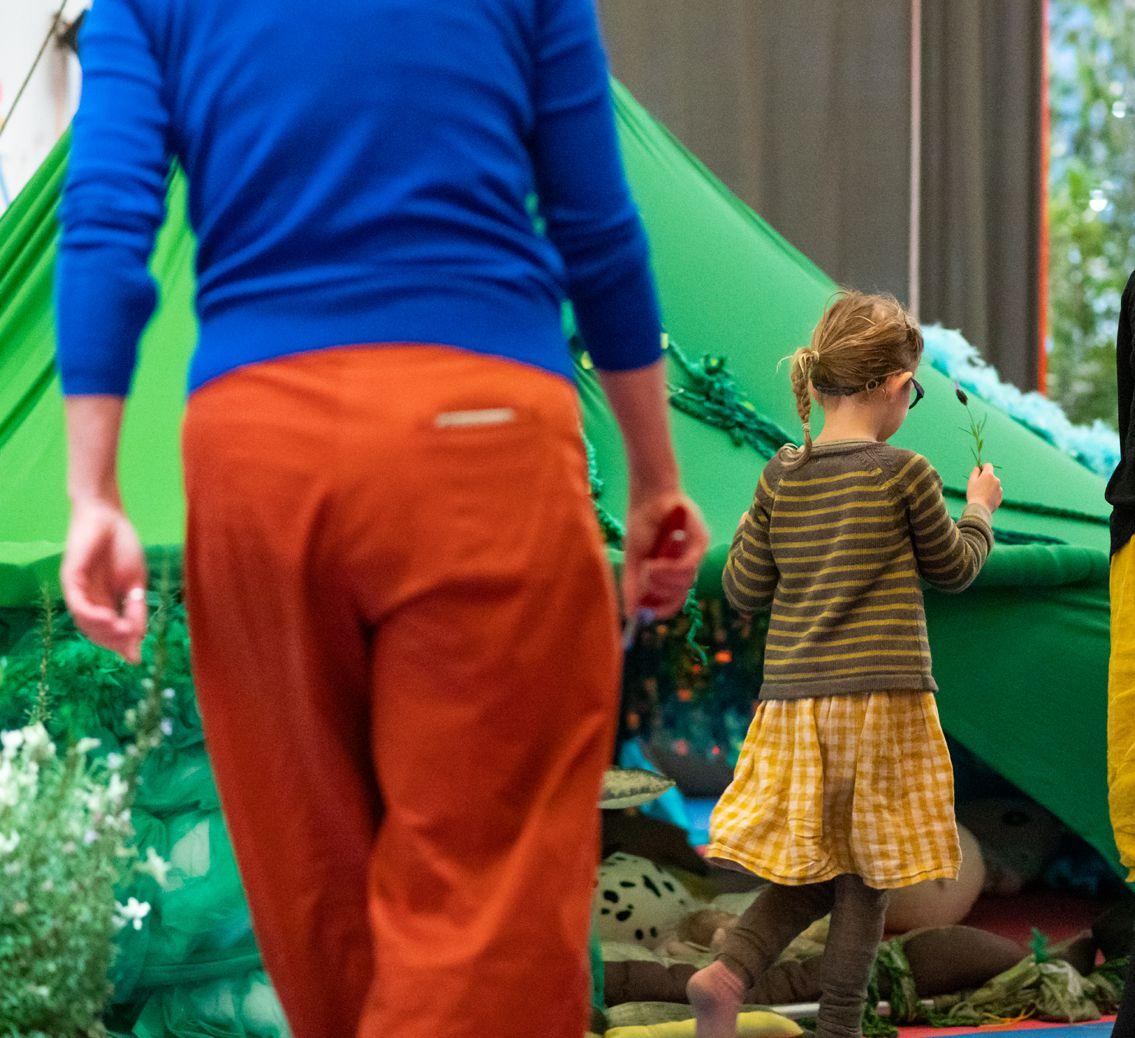
70

Archives of Feeling 71
Miniature Worlds, a workshop guided by Heather Hesterman for The Children’s Sensorium in Archives of Feeling: Sensation, Connection, Community. Image courtesy of the artist. Photograph by Keelan O’Hehir.
Artist Biographies
Rushdi Anwar
Rushdi Anwar is a visual artist, researcher, silent activist, community engager and social equity seeker, living between Melbourne, Australia and Chiang Mai, Thailand. Anwar is originally from Halabja, Kurdistan-Iraq. He holds a Master of Fine Art (2010) and a Doctor of Philosophy in Art (Ph.D., 2016), from the School of Art at RMIT University, Australia and is currently a lecturer in the Faculty of Fine Arts, Chiang Mai University, Thailand. His numerous solo and group exhibitions include recent presentations at the Biennial of Casablanca, Morocco (UPCOMING); Bangkok Art Biennale, Thailand (2020); and Havana Biennial, Cuba (2019).
Tamara Borovica
Tamara Borovica (she/her) is an academic, creative artist, and embodiment and creative movement practitioner. Borovica’s expertise is in embodied and arts-based methods for participatory research inclusive of non-normative ways of knowing. Her practice includes creative movement and embodiment programs for various audiences to explore links between movement, embodiment, creativity, belonging and well-being. Her interests traverse intersections between dance, philosophy, arts, psycho-social sciences and creative practice in the everyday.
N’arweet Carolyn Briggs
N’arweet Carolyn Briggs AM is a Boon Wurrung senior elder and Professor in the College of Design & Social Context at RMIT University. A descendant of the First Peoples of Melbourne, the Yaluk-ut Weelam clan of the Boon Wurrung and the Wamba Wemba of the Murray River, she is the greatgranddaughter of Louisa Briggs, a Boon Wurrung woman born near Melbourne in the 1830’s. N’arweet Carolyn has been involved in developing and supporting opportunities for Indigenous youth and Boon Wurrung culture for over 40 years. In 2005, she established the Boon Wurrung Foundation, which has been responsible for significant work in cultural research, including restoration of the Boon Wurrung language, and is also a Board Member of the Boonwurrung Land and Sea Council.
Che-Wei Chen
Che-Wei Chen’s practice reflects upon the complexity of mental health issues, subjectivity and contemporary conditions. He explores the boundaries between reality and fiction through multiple perspectives within complex structures and narratives. Chen’s work not only reveals the repressed collective unconscious, but also re-examines the power and political structures underlying the social system. He also addresses issues of postcolonialism, modernity, classification and biopolitics.
The Children’s Sensorium
‘The Children’s Sensorium’ is a space for children to engage with and explore their senses, feelings, thoughts, worries and hopes. It includes a variety of materials to play with and a range of things to see, touch, smell, hear, taste and sense. With artistic direction from Boonwurrung elder N’arweet Carolyn Briggs, the sensorium draws on themes of nature and marks the seasonal transition from Guling, or orchard season (August), to Poorneet, or tadpole season (September/October), in the local Kulin calendar.
‘The Children’s Sensorium’ includes wall and ceiling design drawings by children artists Artis Clarke, Skye Nguyen and John McLeod.
Volunteers and project development support of ‘The Children’s Sensorium’ by Keyu An, Erin Bussell, Alex Castellarnau Feitoza, Alicia Crowhurst, Alex Danay, Xueying Fu, Moon Girle, Nao Hirata, Raghav Kumar, Anita Kwong, Wensi Li, Harper Liu, Indra Liusuari, Wenting Ma, Angelo Mao, Celline Mercado, Thao Nguyen, Vivian Qiu, Yvonne Rambeau, Jahan Rezakhanlou, Kelly So, Fiona Soeding, Sze Tjin Yek, Anthea Vayonitis, Catherine Weng, Pug (Alexander Williams), Selena Xiao, Sirui Yang, Dominik Zarowny, Emma x Zhang and Wang Zi Yu.
Peta Clancy
Artist Peta Clancy gained a BA Fine Art and an MA Media Arts at RMIT University. Through her photographic work she explores hidden histories of colonisation. In 2018 she was awarded the inaugural Fostering Koorie Art and Culture grant from the Koorie Heritage Trust. For this project Clancy collaborated with the Dja Dja Wurrung community to create a body of work investigating massacre sites on local country. Clancy is currently a Senior Lecturer at Monash University’s Art, Design and Architecture Faculty.
Anthony Clarke
Anthony Clarke is an architect, university lecturer, and PhD candidate. Anthony established BLOXAS is 2010, a practice for empathic and experimental architecture. BLOXAS is led by research, experimentation and curiosity. These elements are inherent in the practice’s philosophy, driving an interrogative and empathetic response. Specialists from a variety of disciplines contribute to BLOXAS’ curative understanding of individual and collective behaviour, sensory perception, physiology and phenomenology. BLOXAS investigates how people affect—and are at the effect of—its designs.
72
Maree Clarke
Maree Clarke is a Mutti Mutti, Yorta Yorta, BoonWurrung woman from Mildura in northwest Victoria currently living and working in Melbourne. She is a pivotal figure in the reclamation of southeast Australian Aboriginal art practices and a leader in nurturing and promoting the diversity of contemporary southeast Aboriginal artists. Her continuing desire to affirm and reconnect with her cultural heritage has seen her revivification of the traditional possum skin cloaks, together with the production of contemporary designs of kangaroo teeth necklaces, and river reed necklaces, alongside multi-media installations of photography and video work. Maree Clarke is represented by Vivien Anderson Gallery.
Simon Crosbie
In 2017 Simon Crosbie commenced his PhD in the School of Art at RMIT University. His project: ‘Trauma, dissociation and the boarding school experience’ draws upon personal experiences of child abuse at a Catholic boarding school. The primary challenge in this project involves a process of articulating aspects of memory and affect that are complex, fragmented and sometimes unintelligible. This project explores the use of textiles to evoke memory. Crosbie has exhibited extensively and recently presented at academic conferences in Palermo, Vienna, Dubrovnik and Edinburgh.
Mig Dann
Mig Dann is a Melbourne / Naarm-based artist, writer and researcher, whose practice is multidisciplinary and autobiographical. In 2022 she completed her practice-led PhD in the School of Art at RMIT University. Dann’s work is informed by memory and forgetting, absence and presence, feminism, queer culture and decades of lived experience. She explores the politics of memory, time, identity and personal cultural history through sculptural forms.
Graeme Doyle
Graeme Doyle was an artist, poet, musician and performer with a great passion for art making. He has works held by the National Gallery of Australia and a number of private collections. He experienced schizophrenia and bipolar disorder since the age of 18 and described himself as a ‘grim survivor with extraordinary courage.’ Graeme made the decision that he would live a full life despite schizophrenia and found it enhanced his art in many ways.
felt Experience & Empathy Lab (fEEL)
The felt Experience & Empathy Lab (fEEL) is funded through the Australian Research Council Laureate Fellowship awarded to Scientia Professor Jill Bennett, Director of the Big Anxiety Research Centre. fEEL brings together specialists in immersive media, participatory design, trauma studies and psychosocial studies to advance new methods in the study of embodied subjective experience—focusing on trauma and mental health.
- Jill Bennett – Australian Research Council Laureate Fellow and Project Director
- Volker Kuchelmeister – Research Fellow in Immersive Visualisation
- Gail Kenning – Postdoctoral Fellow in Participatory Design
- Lydia Gitau – Postdoctoral Fellow in Psychosocial Practice Bec Moran – NHMRC ALIVE Lived Experience Engagement Fellow Melissa Neidorf – Manager
Julie Gough
Julie Gough is an artist, writer and curator based in Hobart. Her art/research often uncovers and re-presents conflicting and subsumed histories. Her (Briggs-Johnson-Gower) family have lived in the Latrobe region of Lutruwita (Tasmania) since the 1840s, with Tebrikunna their northeast Trawlwoolway Traditional Country. Publications include ‘Tense Past’ (Tebrikunna Press, 2021), ‘Fugitive History’ (UWA Press) and ‘Shale’ (A Published Event), both 2018. Gough’s artworks, held in many national collections. Recent exhibitions include ‘Rīvus’, Biennale of Sydney, 2022; ‘Tarnanthi’, Art Gallery of South Australia, 2021 and ‘Eucalyptusdom’, Powerhouse Museum, 2021.
Heather Hesterman
Heather Hesterman is an artist/educator/researcher based in Naarm/ Melbourne interested in the intersections of plants, people and places. Her practice is informed by research in climate change, history and plant studies. With a background in print, installation and landscape design, Hesterman activates spaces through plant-human relations, aiming to foster ‘vegetallove’ through gifting, walking practices, mobile devices, collaborative acts and conversations. Reflecting upon plant methodologies, she encourages humans to increase ‘botanical literacy’ by slowing down and becoming attuned to the vegetal beings upon whom humans rely for survival.
Archives of Feeling 73
Jenny Hickinbotham
Jenny Hickinbotham’s work encompasses writing, video, sculpture, and songs. Laced with humour, pathos and searing critique, Hickinbotham’s songs are informed by childhood experiences. Growing up she was diagnosed with developmental trauma and complex post-traumatic stress, which culminated in the schizophrenia label in early adulthood. The artist has ‘heard voices’ for most of her life and her work explores her ongoing struggle to challenge the institutional pathologising of these experiences. Understanding these internal voices, listening, giving meaning to them, singing them, and considering their relation to the ghosts of the past and present, is a preoccupation of her work.
Fiona Hillary
Fiona Hillary is a Melbourne-based artist working in the public realm. Her passion lies in site specific practices and the human/non-human relationships that reveal themselves across time. Exploring scale through publicly shared moments of awe and wonder to more personal and intimate encounters, she asks us to consider who and what we are in the process of becoming? Working with site, neon, sound, human and non-human companion species, her work focusses on temporary, fleeting encounters in and of the everyday. Hillary has made and curated permanent, temporary, collaborative, performative works for a range of commissioning organisations.
Live Particle
Live Particle is an independent embodied education and therapeutics provider delivering classes, art interventions, courses and online resources for people of all ages and abilities. Live Particle is the collaboration of Angela Clarke PhD and Camilla Maling (art therapist), who are embodiment, education, and creative practice specialists. They craft experiential sensory encounters for physical and mental wellbeing. Both with 20+ years as multidisciplinary artist/educators Camilla and Angela respectively have worked in studios, universities, communities and schools and supported people in physical and mental health, creative practice, body awareness, various movement and vocal practices, performance, storytelling and improvisation. Live Particle is dedicated to delivering sustainable pathways for healthy, connected, and creative communities through embodied practice.
Brian McKinnon
Brian McKinnon was born to an Amungu mother and Wongai father and grew up in a Geraldton fringe camp named Blood Alley at the foot of Mount Misery. McKinnon left home at the age of twelve to work along Western Australia’s coast wherever he could. At 18 he settled in Geelong, Victoria and has exhibited widely since 1996, nationally and internationally showing powerful work that addresses his experiences of growing up in Western Australia’s Mid West and the ongoing challenges of Aboriginality in today’s world. McKinnon is an inaugural Vice Chancellor’s Pre-doctoral Indigenous Fellow with RMIT School of Art and is completing a PhD by practice with RMIT University.
Bec Moran
Bec is a criminologist who focusses on complex trauma: particularly the trauma of child sexual abuse. Her PhD explores ‘survivor missions’ and the ways that people healing from trauma might find recognition and drive social change through social action and public testimony. Bec is interested in the personal and the political, as well as social justice, dignity, service reform, and recognition for marginalised groups, including trauma survivors and older adults. Bec also has a long history as a mental health and justice reform advocate/activist, including utilising her lived experience of complex trauma to assist in teaching and training about trauma, with the aim of facilitating transformative learning experiences.
NPY Women’s Council
Ngaanyatjarra Pitjantjatjara Yankunytjatjara (NPY) Women’s Council Aboriginal Corporation is led by NPY women’s law, authority and culture and is one of Central Australia’s key service providers supporting Aboriginal health, social and cultural wellbeing. The NPY Women’s Council’s Ngangkari Program supports a dynamic group of ngangkari (traditional healers) who are highly respected educators, community leaders, multi-form artists, health professionals and land managers. As well as applying their traditional skills as healers in their communities, they provide advice to Indigenous and non-Indigenous people outside of their communities, using their extensive knowledge of culture and family.
The Uti Kulintjaku Collective has grown from the NPY Women’s Council’s Ngangkari Program. It takes its name from a Pitjantjatjara phrase that means ‘to listen, think and understand clearly.’ Formed in 2012, it’s a multi-awardwinning arts and social innovation project, initiated and led by senior Anangu women and ngangkari. Uti Kulintjaku works to address cycles of trauma and improve the mental health and wellbeing of Aboriginal people in remote desert communities, developing innovative arts and media to explore the psychosocial and physiological experiences of trauma and depression.
Uti Kulintjaku boosts the capacity of NPY women to address mental health and related issues in ways that draw on their strengths, traditional knowledge and culture as well as their new knowledge of western mental health. It supports the capacity of the local mental health team to engage with and communicate more effectively with Anangu, to see ‘through their eyes.’
74
The Nurses and Midwives Art Exchange
This project aimed to create an archive of pandemic responses that activates public conversation about the ongoing effects of the pandemic on nurses and midwives. The Nurses and Midwives Art Exchange featured artworks, objects and stories that were made by nurses and midwives who worked during the pandemic. Each of these works was accompanied by a creative response made by a local artist, which will be gifted to participating nurses and midwives at the end of the exhibition.
The Nurses and Midwives Art Exchange participating artists include (artists listed in alphabetical order by nurses and midwife’s last name followed by paired local artist): Cora Browne, Peter Bridson and the ‘Corona Choir’ (Kate Coombs, Kathleen Corless, Katherine Kyrkou and Anita Cappello) & Kate Stewart; Sarah Colahan & Aurora Markel; Gabrielle Cosgri Hatty & Ka Yan So (Kelly); Sue Denmead & Moon Girle; Jess Dillard-Wright & Hannah Hall; Shaley Ellis & Vivian Qiu; Lynne Evans Abbott & Kelly Hussey-Smith; Carol Giles & Julienne Nyste; Katherine Handasyde & Beth Sanderson; Ruth Harper & Harry McCumiskey; Christina Haynes & Vittoria Di Stefano; Jo Henderson & Charlotte Hall; Jane Hopkins-Walsh & Marnie Badham; Mim Johnson & Koa Wamsteker; Angela Kelly & Angelina Innocent; Danielle Kiriati & Jessica Guo; Crystal Labbato & Leesha Wild; Amanda Larcombe & Prue Wilkinson; Vanessa Mayanja & Cecilia Sordi Campos; Viki Mealings & Mia Presland; Yvonne Mckinlay & Tracey Jones; Suzanne Neal & Aisha Hara; Sarah (Seung) Park & Evelyn Challinor; Helen Rawson & Fleur Summers; Laura Roos & Kate Driscoll; Mishalle Santos & Yi Yonah Ma; Xander Savage & Debra Higgens; Shelby & Alex Danay; Jerry Soucy & Oliver Biggins; Jill Spencer & Jiaxin Shi; Georgia Sutherland & Sunday Smith; Kimberley Thomas & Mark Edgoose; Stephanie Vienet & Clare McCracken; Subathra Vijayakumar & Alice Jordan; Brad Wishart & Alan Hill; Rachel Wood & Sarah Lockey; Shiyi (Andrea) Wu & Robyn Phelan; and Tatiana Zecher & Rose Smith.
‘The Nurses and Midwives Art Exchange’ team includes: Ruth DeSouza, Mark Edgoose, Kelly Hussey-Smith, Grace McQuilten, and Fleur Summers.
Yi Won Park
Yi Won Park is a Korean-Australian artist based in Melbourne. She often draws upon her experience living between cultures within her creative practice, having grown up in Korea and immigrating to Australia in 2003. Park is interested in cross-cultural art projects between Australia and Korea, working as a liaison and participating artist for ‘Korean-Australian contemporary prints’ in 2016. Park has exhibited work in Seoul, Sydney, Hong Kong and Melbourne. Park participated in the Artist in Residency program at Artspace Hue in Korea from 2015-2018 and Camac-Centre d’Art Marnay in France in 2012.
Playbour Inc.
Distinguished Professor Larissa Hjorth is a socially-engaged artist and digital ethnographer. Hjorth has two decades experience working in interdisciplinary, collaborative, playful and socially innovative digital media methods to explore intergenerational relationships in cross-cultural contexts. Hjorth has explored the socio-cultural dimensions of mobile media in many contexts, including Japan, South Korea, China and Australia. Much of her participatory art projects seek to provide playful critical reflection on quotidian environment and media practices from mobile games about climate change, to transforming the gallery into a Minecraft/Lego game to what happens to our data after we die (#dataofthedead).
Dominic Redfern
Dominic Redfern is an artist and academic with a keen interest in historical vectors that inform the human condition and the state of the planet more broadly. Redfern is always interested in origin stories and his key interests are in evolution (including the evolution of consciousness, and aesthetics in particular), geography in the expanded field, and biology (including the biology of consciousness, and aesthetics in particular). He typically works with video in multi-screen installations, but also makes single channel and live screen works. Redfern has undertaken residencies and site-responsive projects in Australia and internationally.
Philip Samartzis
Philip Samartzis is a sound artist, researcher and curator with a specific interest in the social and environmental conditions informing remote wilderness regions and their communities. His art practice is based on deep fieldwork where he deploys complex sound recording technology to capture natural, anthropogenic and geophysical forces. The recordings are used within various exhibition, performance and publication outcomes to demonstrate the transformative effects of sound within a fine art context. He is particularly interested in concepts of perception, immersion and embodiment to provide audiences with sophisticated encounters of space and place.
Mariela Sancari
Mariela Sancari was born in Buenos Aires, Argentina, and has lived and worked in Mexico City since 1997. She is a self-taught artist who reclaims practice and thought outside the hegemonic circuits of validation and training. Her work revolves around truthfulness and fiction in images, using personal narratives to explore the boundaries of the scope of photography as a means of representation. Sancari has participated in numerous solo and group exhibitions across South America, Europe, the UK and America. She is also the founder of FOLIO, Centro de la Imagen’s public photobook collection.
Archives of Feeling 75
Anna Schwann
Anna Schwann works in an expanded sculptural practice that investigates the encounter between art and audience. Through playful resistance and embracing failure, she facilitates a conversation using sensory engaging tactics as means of connection. Taking a DIY approach to technique, Schwann utilises provisional, accessible materials for making and uses everyday objects in her narrative.
Thembi Soddell
Dr Thembi Soddell is an artist and practice-based researcher known for their powerful acousmatic sound performances and installations in darkness. Their PhD research, titled ‘A Dense Mass of Indecipherable Fear: The Experiential (Non)Narration of Trauma and Madness through Acousmatic Sound’, explored a novel approach to understanding lived experiences of ‘mental illness’ using a medium (abstract sound) with a unique ability to reflect the intangibility of the inner world. Its associated album, Love Songs, was praised for its ‘innovative approach to form’ (Fluid Radio) and its launch won the 2019 Green Room Award for Contemporary Sound Performance.
Hiromi Tango
Hiromi Tango is an Australian-based artist whose practice intersects with arts, health, nature, and neuroscientific research. Tango has dedicated her practice to exploring the mental health benefits of arts engagement. Her studio practice and community projects explore how art-making can contribute to positive mental wellbeing. She is currently working on a major public artwork, ‘Garden | Healing Together’, for Tweed Valley Hospital that contemplates the many ways that connecting with nature supports wellbeing. Tango’s works have been exhibited at major galleries across Australia and internationally and are held in key public and private collections. Hiromi Tango is represented by Sullivan+Strumpf Gallery.
The Vessel of Time
This project is a collaboration between Che-Wei Chen and the residents of the Taipei Veterans’ General Hospital Yuli Branch, located in Hualien, Taiwan. Most of the participating residents live with schizophrenia and have either been rejected from medical treatment at other institutions, by their families, or by society. As a gesture of fostering community, Chen hosted a series of painting workshops that invited residents to consider how a vessel floating on an ocean of time could be a metaphor for one’s life. Participants were asked to draw or paint their own personal interpretation of this vessel of time, offering them the opportunity to revisit personal narratives, complex past experiences and submerged memories.
‘The Vessel of Time’ participating artists include (all artists have been referred to with pseudonyms, which are listed in alphabetical order): A Chou,
A Gang, A Hsia, A Hua, A Peipei, A San, A Te, A Yu, An Ling, Anthony, Apple, Cheng Yuan Chun, Chin Ke, Chou, Chu Ai, David, Golden Sword, Gui, Hsian Shen Mei, Hsiao Chiao, Hsiao Ching, Hsiao Chun, Hsiao En, Hsiao Fan, Hsiao Fang, Hsiao Hua, Hsiao Jie Lun, Hsiao Jung, Hsiao Li, Hsiao Mei, Hsiao Ping, Hsiao Shan, Hsiao Ting, Hsiao Yu, Hsin Yi, Hua Bu, J.F.S., Jason, Joe, John, Kai Hsuan, Kao Hsuan, Kitty, Li, Li Li, Li Yun, Little Star, Mei Mong, Michael, Michael Wu, Paul, Ronin, Sandy Chin, Shu Chen, Sister Luo, Star, Su Ying, Sun Tung Ying, Tan Jan, Tien Ho, Ting Ting, Tsai Hui, Tung Sheng, Wen Hsiao Chu, Wen Hua, and Yeh Hsiang Hua.
‘The Vessel of Time’ project was organised by Che-Wei Chen.
Julie Watkins
Melbourne artist Julie Watkins investigates the vulnerability of women through her interdisciplinary practice incorporating photography, photomontage, painting, print processes and installation. Her photographic works are inspired by Australian inland travel and the locality of St Kilda, where Watkins’ studio has been established since the 1970s. Abandoned urban sites and outback ruins form theatrical backdrops for Watkins’ semiautobiographical female figures who act out dramatic narratives of sexuality, gender, ambiguity and abandonment. Watkins is a fine art graduate of RMIT University and former Associate Lecturer at RMIT and the Victorian College of the Arts.
Jude Worters
Born in New Zealand, Jude Worters settled in Melbourne in 1988. Worters’ multi-disciplinary practice encompasses soft sculpture, self-portraiture, costume and installation. Her recent projects explore the legacy of trauma and the transformative nature of the creative process. Worters completed a bachelor’s degree at the Victorian College of the Arts and a Graduate Diploma of Education at Melbourne University. On graduating she began teaching Art at the Victorian Centre for Adult Education. She is currently engaged in PhD research at RMIT University in Melbourne, where she also completed a Masters in 2016.
76
Writer Biographies
Ann Cvetkovich
Ann Cvetkovich is currently Professor in the Feminist Institute of Social Transformation at Carleton University in Ottawa, Ontario, Canada. She has been Ellen Clayton Garwood Centennial Professor of English and Professor of Women’s and Gender Studies at the University of Texas at Austin. She is the author of ‘Mixed Feelings: Feminism, Mass Culture, and Victorian Sensationalism’ (Rutgers, 1992); ‘An Archive of Feelings: Trauma, Sexuality, and Lesbian Public Cultures’ (Duke, 2003); and ‘Depression: A Public Feeling’ (Duke, 2012). She co-edited (with Ann Pellegrini) ‘Public Sentiments’ a special issue of The Scholar and Feminist Online, and (with Janet Staiger and Ann Reynolds) Political Emotions (Routledge, 2010). She has been coeditor, with Annamarie Jagose, of GLQ: A Journal of Lesbian and Gay Studies. Her current writing projects focus on the current state of LGBTQ archives and the creative use of them by artists to create counterarchives and interventions in public history.
Curator Biographies
Kelly Hussey-Smith
Kelly Hussey-Smith is an artist, researcher, and educator focused on photography as a social practice, the politics of representation, and community-oriented art education. She has exhibited and published widely and is a Lecturer in Photography at the RMIT School of Art. Her most recent work explores the relational and ethical conditions of collaborative work and artist-led approaches to public pedagogy in the Asia-Pacific region.
Grace McQuilten
Grace McQuilten is an art historian, curator and writer, and Associate Professor in the School of Art at RMIT University, Australia. She has published widely on contemporary art, design, social enterprise and community development. Grace has curated exhibitions and public events across a range of venues including the Ian Potter Museum of Art, the Immigration Museum, Federation Square, Monash University Museum of Art and the National Gallery of Victoria.
Helen Rayment
Helen Rayment is Manger Creative Production and is responsible for the development and management of the creative programming strategy for the galleries across RMIT Culture. She has broad experience both curating and organising a range of complex exhibition projects. Her special areas of curatorial interest and expertise includes the development of cultural partnerships between contemporary artists and crafts people. She was the recent recipient of an Australia Council Professional Development Grant aimed at supporting Australian artists engagements in India.
Andrew Tetzlaff
Andrew Tetzlaff is the Senior Curator for RMIT Culture. He has a history of working in exhibition development, tertiary education, international project development and grass-roots cultural organisations. Tetzlaff has lectured, presented and written critically on contemporary art and curation. From 2008 to 2017 Andrew served on the board of BLINDSIDE, an artist-run initiative located in the heart of Melbourne, and since 2020 he has served as the Vice President of the Public Galleries Association of Victoria board. He holds an MFA from RMIT University, where he is presently pursuing a PhD.
Archives of Feeling 77
Brian McKinnon
see Artist Biographies
Exhibition staff
Manager Creative Production
Helen Rayment
Senior Curator
Andrew Tetzlaff
Exhibition
Lisa Linton
Engagement Officer
Exhibition Officer

Sarah Werkmeister
Curatorial Assistant
Michaela Bear
Technical Collections Coordinator
Nick Devlin
Production Coordinator
Erik North Production Officer
Tim McLeod

Production Officer (Sound)

Simon Maisch
Production Assistants
Bec Bartlett, Olivia Borghesan, Robert Bridgewater, Mason Cox, Nikolaus Dolman, Yvette James, Elliot Taylor, Jonty Ransome, Ari Sharp
Exhibition Assistants
Louise Meuwissen, Celine Saoud
Gallery Attendants
Sophie Bishop, Lowell Demetia, Bonnie Lee, Audrey Merton, Jemima Penny, Bek Steel, Kyla Sun, Andari Suherlan, Melissa Viola
The Children’s Sensorium Front of House Assistants
Alex Danay, Bridget Lenehan, Kelly So, Vivian Qiu
The Big Anxiety festival staff
Festival co-directors
Jill Bennett (UNSW) and Renata Kokanović (RMIT)
Forum Convenors
Jill Bennett, Bec Moran, Renata Kokanović, Emma Seal and Tamara Borovica. Forum program curators: Jill Bennett, Bec Moran. Executive Producer: Nigel Lavender. Production manager: Ari Sharp. Organising team: Esther Perini, Xavier Hazard, Robert Prespanoski, Melissa Neidorf. Exhibition component: Gail Kenning
RMIT Culture
Paula Toal, Ali Barker, Helen Withycombe, Else Fitzgerald, Sally Grainger, Elizabeth Marsden
Awkward conversation co-curators
Ali Barker, Else Fitzgerald, Helen Withycombe
Volunteer coordinators
Dimitrios Koutsoukos, Michael Swadling. Governance Team
Jill Bennett, Renata Kokanović, Grace McQuilten, Megan Sheehy, Paula Toal, Ali Barker, Helen Rayment, Bronwyn Gresham, Helen Withycombe, Amy Harrington
78
This publication has been published on the occasion of the exhibition Archives of Feeling, a part of the RMIT Culture program which occurred from 19 August to 8 October 2022 at RMIT Design Hub Gallery and from 21 September to 10 December 2022 at RMIT Gallery.
This exhibition was collectively curated by Kelly Hussey-Smith, Grace McQuilten, Helen Rayment and Andrew Tetzlaff, with the support of Jill Bennett, Renata Kokanović, and a community advisory. This project was supported by Lisa Linton (public program coordination), Michaela Bear (curatorial support) and Sarah Werkmeister (accessibility coordination). Archives of Feeling is a part of The Big Anxiety festival.
The curators and RMIT Culture would like to thank the exhibition artists, writers, contributors and volunteers for their involvement and dedication to the project, as well as generosity and enthusiasm of the project sponsors and supporters. They would also like to thank The Big Anxiety festival for their support and partnership, the DAX Collection for the loan of Graeme Doyle’s artwork, RMIT’s Contemporary Art and Social Transformation Research Group (CAST) and the felt Experience & Empathy Lab (fEEL). Further, a special thanks to the following individuals for their assistance and support: Jill Bennett, Renata Kokanović, Annie English, Jonathan Crowther, Alan Hill, Chloe McCormick and Kalai McDonald. Finally, they would like to acknowledge the direction and leadership which helped bring this important project to fruition. This includes Paula Toal, Head, Cultural and Public Engagement, RMIT Culture; Adam Seedsman, Executive Director, RMIT Business Development and Partnerships; Professor Tim Marshall, Deputy Vice Chancellor and RMIT Vice President; and Professor Kit Wise, Dean of RMIT School of Art.
Published November 2022
Design by Lachlan Siu Contributing Writers: Ann Cvetkovich and Brian McKinnon
All photographs appearing in this catalogue are by Tobias Titz, unless they are otherwise accredited to another photographer or a still of a digital video.
Rushdi Anwar’s We have found in the ashes what we lost in the fire (2018) was assisted by the Australian Government through the Australia Council for the Arts, its arts funding and advisory body.
Che-Wei Chen’s The Vessel of Time (2017) was originally commissioned by Taipei Fine Arts Museum, Taiwan.
The Children’s Sensorium (2022) was supported by VicHealth.
fEEL’s A Safer Place? Stories from the Emergency Department (2022) was supported by R&I Capability Research Funding, RMIT University.
Thembi Soddell’s Who is Doing What to Whom? (Object Impermanence) (2022) was supported by the Victorian Government through Creative Victoria.
Uti Kulintjaku collective meditations were produced in partnership with Smiling Mind.
Uti Kulintjaku collective’s Tjilku Pirni, Pitja-ya Nyinakati — Dear Children (2021) was supported by ENVATO.
Julie Watkin’s Pandora Series 2: Adolescent Pandora; Pandora becomes a vamp, no (i) (1994) was a gift of Annie English and Alan Wearne.
All images courtesy the artists and their representatives. This catalogue is copyright. Apart from fair dealings for the purpose of research, criticism or review as permitted under the Copyright Act 1968. No part may be reproduced, stored in a retrievable system or transmitted by any means, without the prior permission of the publisher.
The views and opinions expressed in this catalogue are those of the authors and do not necessarily reflect the official policy or position of RMIT University.
RMIT Gallery
RMIT University 344 Swanston Street, Melbourne Victoria 3000, Australia rmitgallery.com
RMIT Design Hub Gallery
RMIT University corner of Swanston and Victoria Streets, Carlton Victoria 3053, Australia designhub.rmit.edu.au @rmitgalleries
Archives of Feeling 79
Archives of Feeling 80


 by Kelly Hussey-Smith, Grace McQuilten, Helen Rayment and Andrew Tetzlaff
by Kelly Hussey-Smith, Grace McQuilten, Helen Rayment and Andrew Tetzlaff











































 Rushdi Anwar, Peta Clancy, Maree Clarke, Graeme Doyle, UNSW fEEL Lab, Julie Gough, Jenny Hickinbotham, Brian McKinnon, Rebecca Moran, Dominic Redfern, Mariela Sancari, T-collective and Julie Watkins.
T-collective includes Simon Crosbie, Mig Dann, Yi Won Park and Jude Worters.
Rushdi Anwar, Peta Clancy, Maree Clarke, Graeme Doyle, UNSW fEEL Lab, Julie Gough, Jenny Hickinbotham, Brian McKinnon, Rebecca Moran, Dominic Redfern, Mariela Sancari, T-collective and Julie Watkins.
T-collective includes Simon Crosbie, Mig Dann, Yi Won Park and Jude Worters.






























